• Malik Nabers scores twice: The New York Giants rookie wide receiver was already top-five in fantasy points at the position heading into the week and now he might be the top player at the position.
• Saquon Barkley dominates for the Philadelphia Eagles: While most running backs struggled to gain many yards in the early window, Barkley averaged nearly 10 yards per carry and scored a touchdown, leading the Eagles to the road victory.
• Unlock your edge with a PFF+ subscription: Get full access to all of our in-season fantasy tools, including weekly rankings, WR/CB matchup charts, weekly projections, the Start-Sit Optimizer and more. Sign up now!
Estimated reading time: 20 minutes
PFF's fantasy football recap focuses on player usage and stats, breaking down all the vital information you need to achieve fantasy success in 2024.
New York Giants @ Cleveland Browns
- Malik Nabers: 8 receptions, 78 yards, 2 touchdowns, 2 carries, 4 yards
- Amari Cooper: 7 receptions, 86 yards, 2 touchdowns
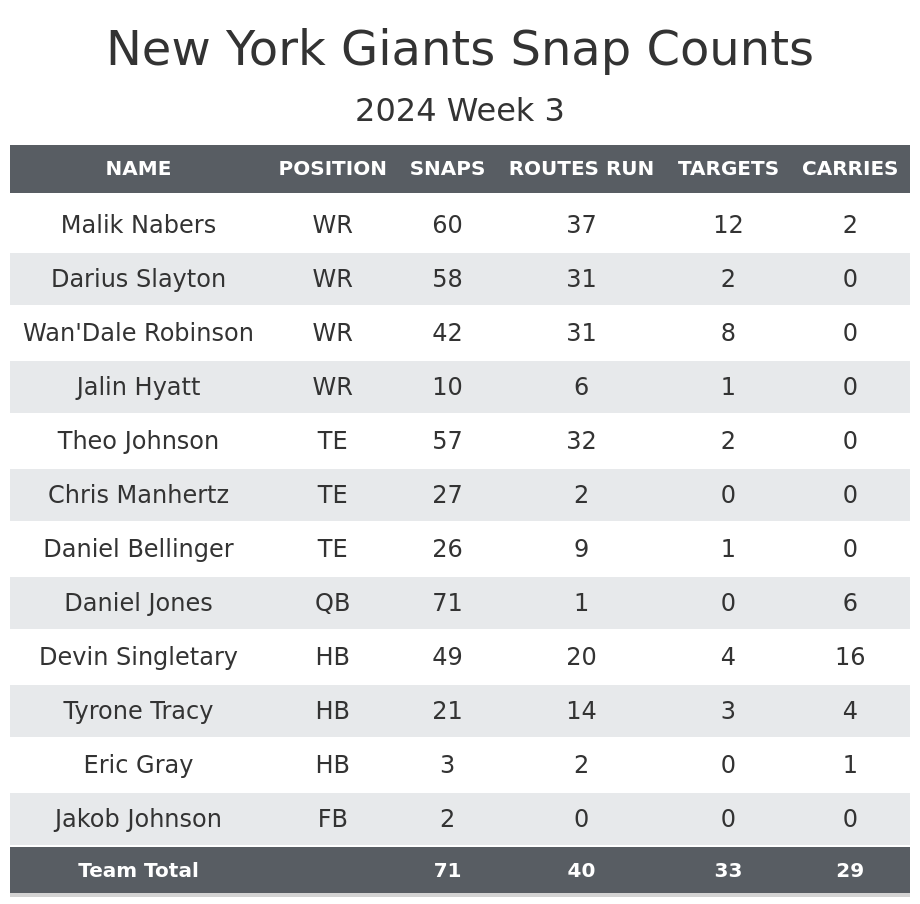
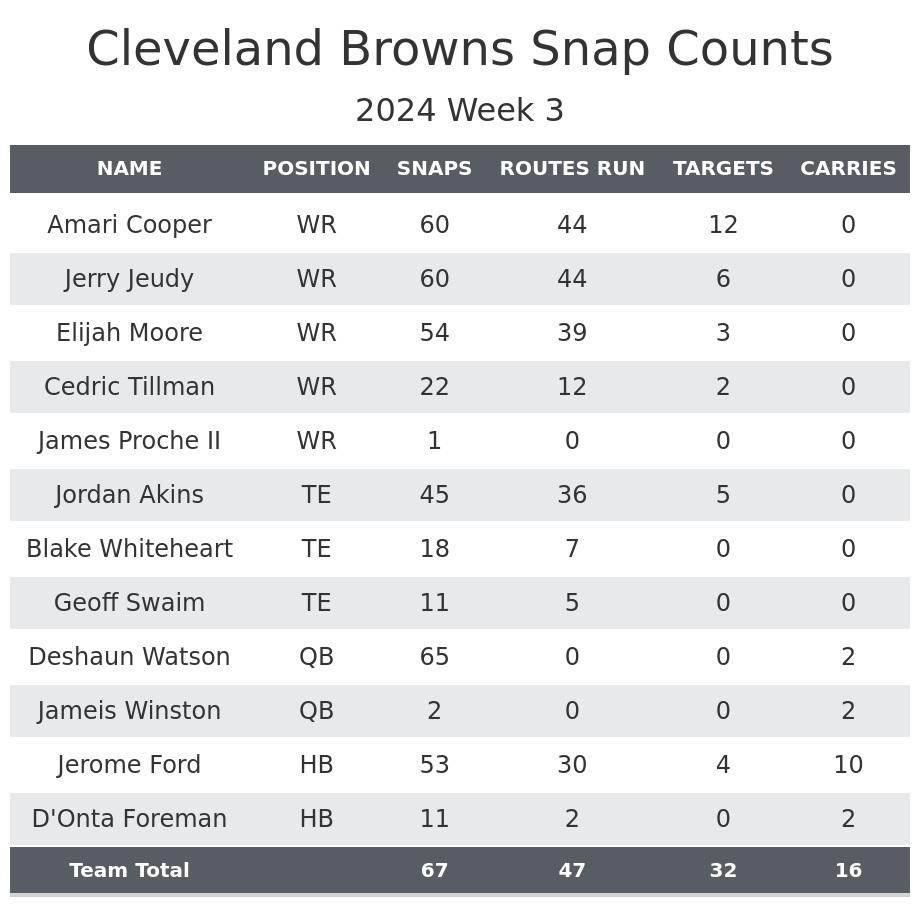
Jerome Ford leads the Browns backfield again: Ford led the team in rushing attempts in Weeks 1 and 3 while D’Onta Foreman led in Week 2.
Ford set career highs in snaps and percentage of Cleveland's offensive snaps in Week 1, but last week, Foreman ran the ball 14 times to Ford's seven. Foreman only played 1 snap in Week 1 and was injured during training camp, so it seemed like what happened in Week 2 would be the new normal.
Pierre Strong Jr. suffered a hamstring injury in Week 2 and missed this week, so we at least knew it would be a two-man backfield. This week ended up being more like Week 1, except Ford played an even higher percentage of Cleveland's offensive snaps, setting a new career high at 79%. While some of this was gamescript-related, Ford started the game and was dominating the snap share even when the Browns had a lead. The one scenario where we most expect to see Foreman is at the goal line, but during the Browns’ two-point conversion attempt, wide receiver Elijah Moore was in the backfield.
This didn’t lead to much fantasy production. Ford gained 37 yards on 10 carries and caught three passes for 33 yards. Even last season, we had some of these dramatic shifts in usage between Ford and Kareem Hunt. It wouldn’t be surprising if this backfield is one of the hardest to predict for fantasy football purposes going forward.

Tyrone Tracy’s role expands: Tracy tied his career-high in offensive snaps by halftime.
During the first two weeks, Devin Singletary dominated the snap share in all situations outside the goal line. This week, Tracy was playing a higher percentage of snaps. This includes a little more work on early downs, a little more on late downs and all of the two-minute drill snaps. Tracy ultimately played 28% of New York's offensive snaps, which was up from the 21% he played each of the first two weeks.
The bright side for Singletary fantasy managers is that Singletary received most of the goal-line work, including a touchdown, which wasn’t the case the previous two weeks. The Giants were facing a strong Browns defense, but it’s worth noting Tracy’s 4.6 yards per carry was higher than Singletary’s 4.1. Tracy was consistently gaining a few yards on his carries, while Singletary had one run for 43 yards to close out the game and a 1.5-yard-per-carry average over the rest of the game. Tracy may continue to play more snaps going forward.
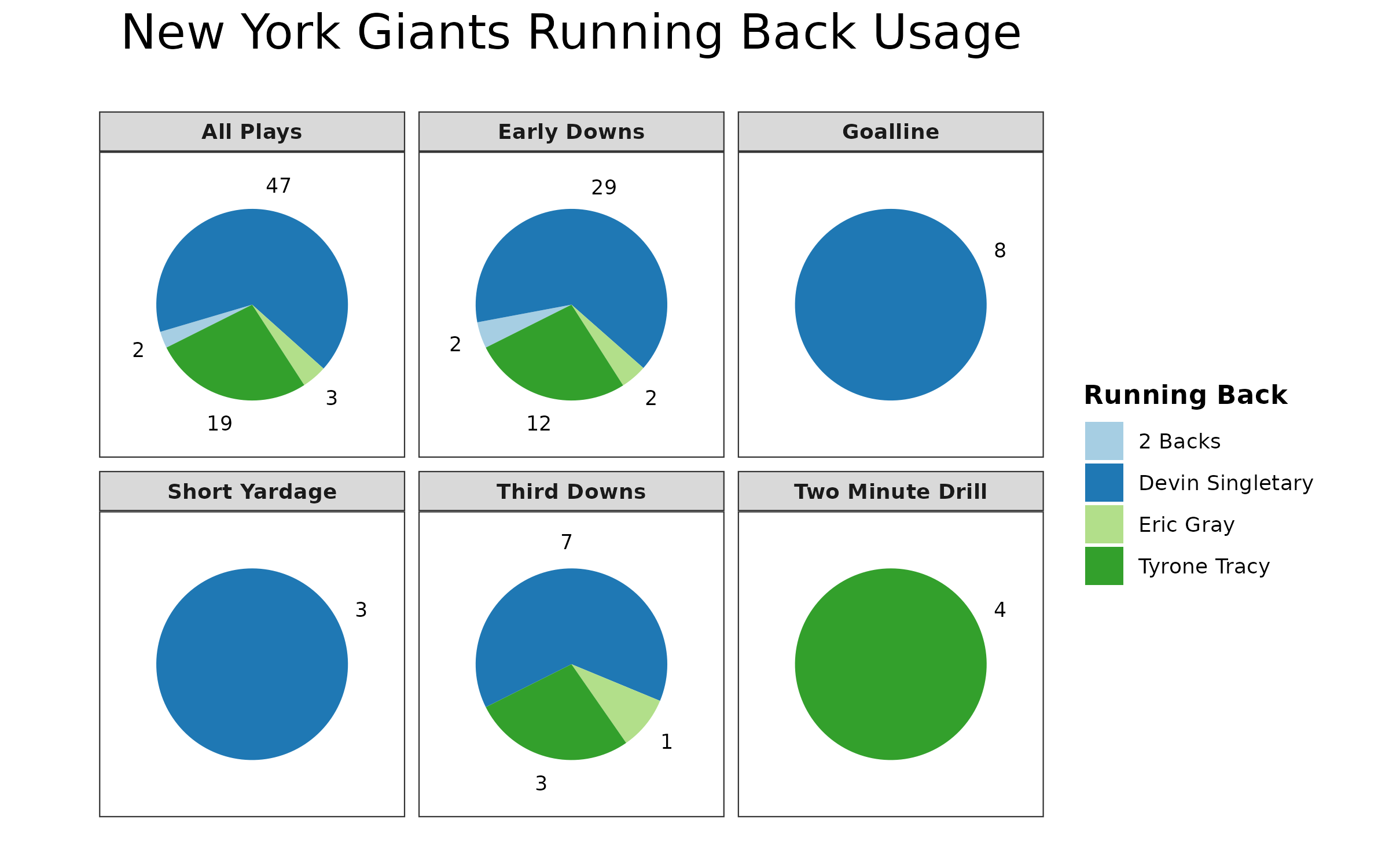
Miscellaneous Notes
- Giants rookie tight end Theo Johnson ran a route on 80% of the Giants’ passing plays, a career-high. He played a slightly higher percentage of offensive snaps, but the big difference was the Giants' tight ends were asked to pass block less often. Over the first two weeks, both Johnson and Chris Manhertz were the clear league leaders in pass blocks among tight ends. Johnson will need a higher target share to seriously consider him in fantasy leagues.
- David Njoku missed his second straight game due to an ankle injury. He didn’t practice all week.
- Rookie wide receiver Jamari Thrash was inactive for a second straight week. James Proche II was the fifth wide receiver. Thrash was on the injury report due to an illness but wasn’t given an injury status.
Chicago Bears @ Indianapolis Colts
- Jonathan Taylor: 23 carries, 110 yards, 2 touchdowns, 1 reception, 25 receiving yards
- Cole Kmet: 10 receptions, 97 yards, 1 touchdown
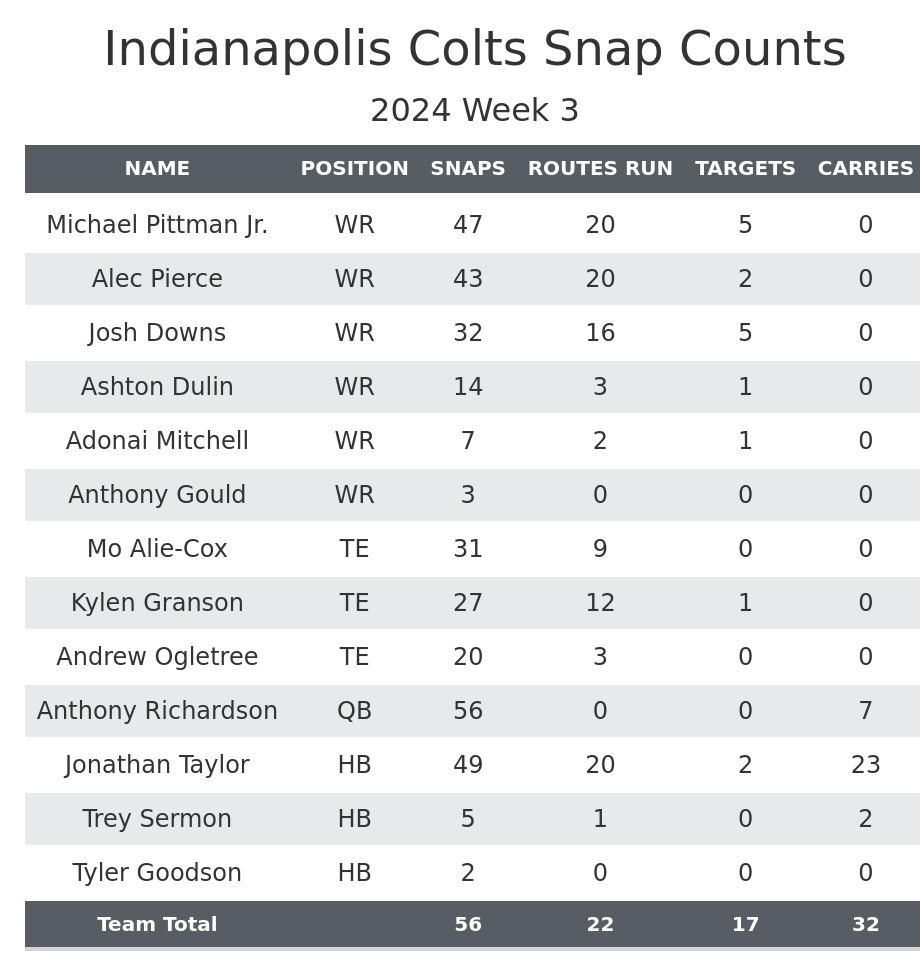
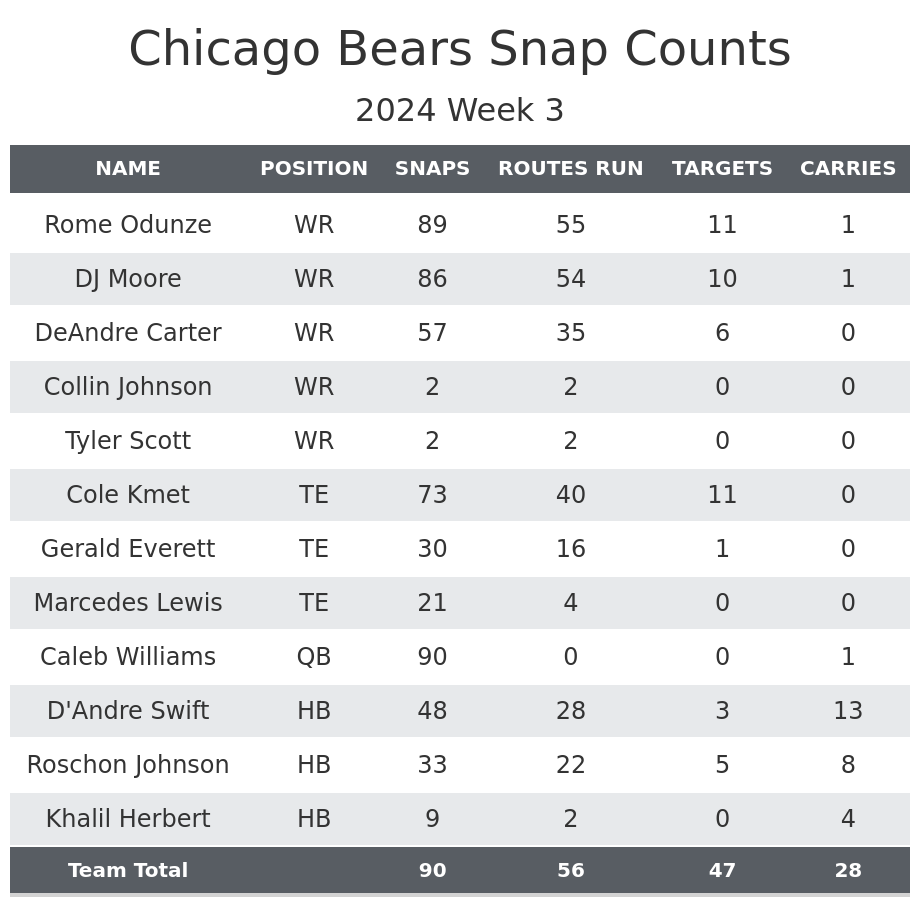
D’Andre Swift’s shrinking role: Swift has averaged 3.0 yards per carry or less in every game and is slowly but surely losing work.
In Week 1, Swift played the clear majority of Chicago's early-down snaps, all of the goal-line work and split third-down snaps with Travis Homer. In Week 2, he lost nearly all of the third-down work to Homer, as Homer played 13 snaps to Swift's one. He also split the goal-line work with Khalil Herbert. On the bright side, Swift took every two-minute drill snap.
Homer suffered a finger injury, which landed him on injured reserve, so Roschon Johnson was active unlike the first two weeks. He took over as the third-down back and did most of the work in two-minute drills. Khalil Herbert took most of the goal-line snaps, while Swift only played one of a possible seven plays in this situation.
Swift continued to play most early-down snaps, but that could be the next thing to go. Swift has averaged 1.8 yards per carry and has one first down on the season, the same amount as wide receiver D.J. Moore, receiving back Travis Homer and Velus Jones Jr., who only played Week 1. Considering Johnson ran the ball eight times for 30 yards Sunday and out-snapped Herbert on early downs, it seems like Johnson is the best waiver option of the group.
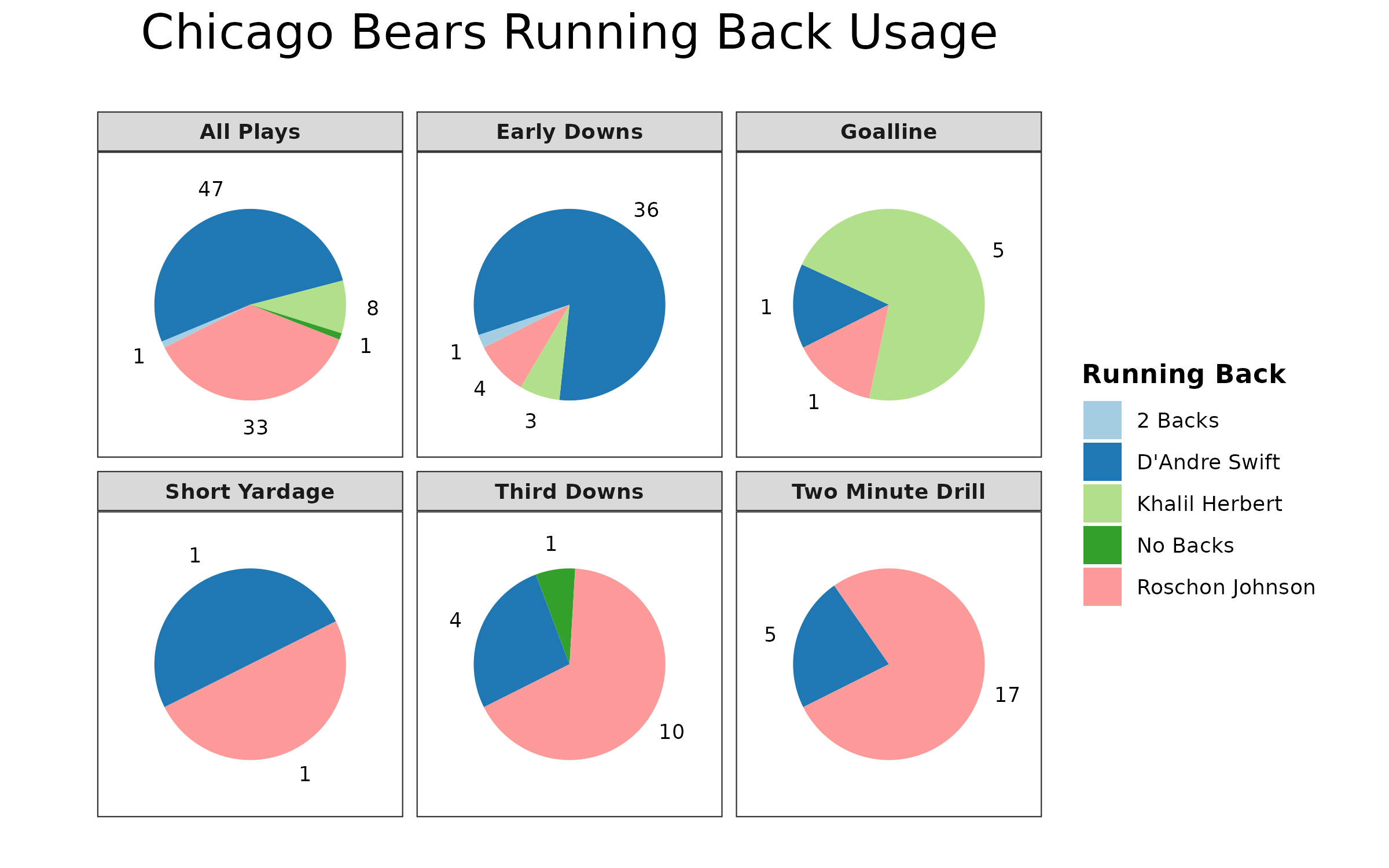
Cole Kmet sees an uptick in snaps played: Kmet was much more heavily involved in the offense this week than in the previous two.
Kmet was behind in a rotation with Gerald Everett in Week 1, but that shifted to Kmet being the leader in Week 2. He played slightly more snaps in Week 3 and saw a lot more targets. His 10 receptions were tied for a career-high while his 97 yards were the second-most in his career.
He still isn’t playing as much as last season, and when he’s off the field, it’s often a passing play. This has remained true in all three weeks, as Kmet is consistently on the field in 12 and 21 personnel, and he's only getting rotated out in11 personnel groupings. Kmet ran a route on 71.4% of the Bears pass plays, which is up 10% from last week, but it is not ideal for a fantasy starter.
This game makes it more likely Kmet can have some fantasy value this season because it showed he has chemistry with Caleb Williams, but we can still expect things to be different when the Bears are running a more normal amount of plays and Keenan Allen is healthy again.
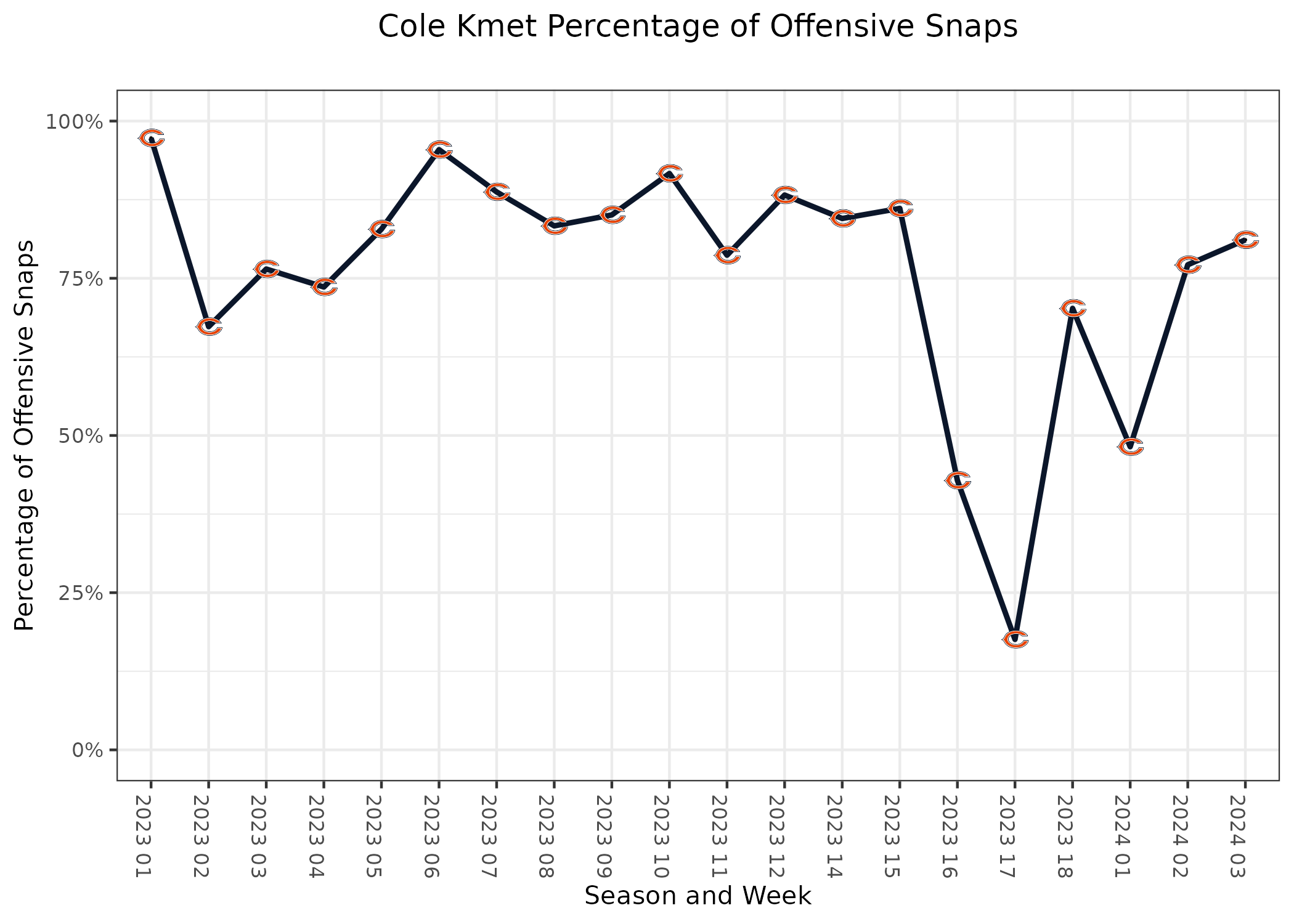
Josh Downs returns for the Colts: Downs missed the first two weeks but was a full participant in practice all week and wasn’t given an injury designation.
Downs went back to the role he played last year in the slot in 11 personnel. He played in 32 of a possible 41 snaps out of 11 personnel while not playing at all in the other personnel groupings.
The Colts spent most of the day running the ball, so Downs only ran 16 routes, but he was targeted on five of them. He caught three passes for 22 yards. The 31.2% target rate in his first game back after missing almost all of training camp is a great sign for his future production. He will be a sneaky waiver-wire target this week.
When he was off the field, Ashton Dulin was on the field often instead of second-round rookie Adonai Mitchell, who played three-of-41 snaps out of 11 personnel. The good news is Mitchell split snaps with Alec Pierce in 12 personnel with four snaps each. Pierce consistently played at least 95% of Indianapolis' offensive snaps last week, so playing 77% in this game is a dramatic decrease. While September is always too early to give up on a rookie for fantasy football purposes, the fact that Mitchell has fallen to a clear fifth on the depth chart is not a great sign.
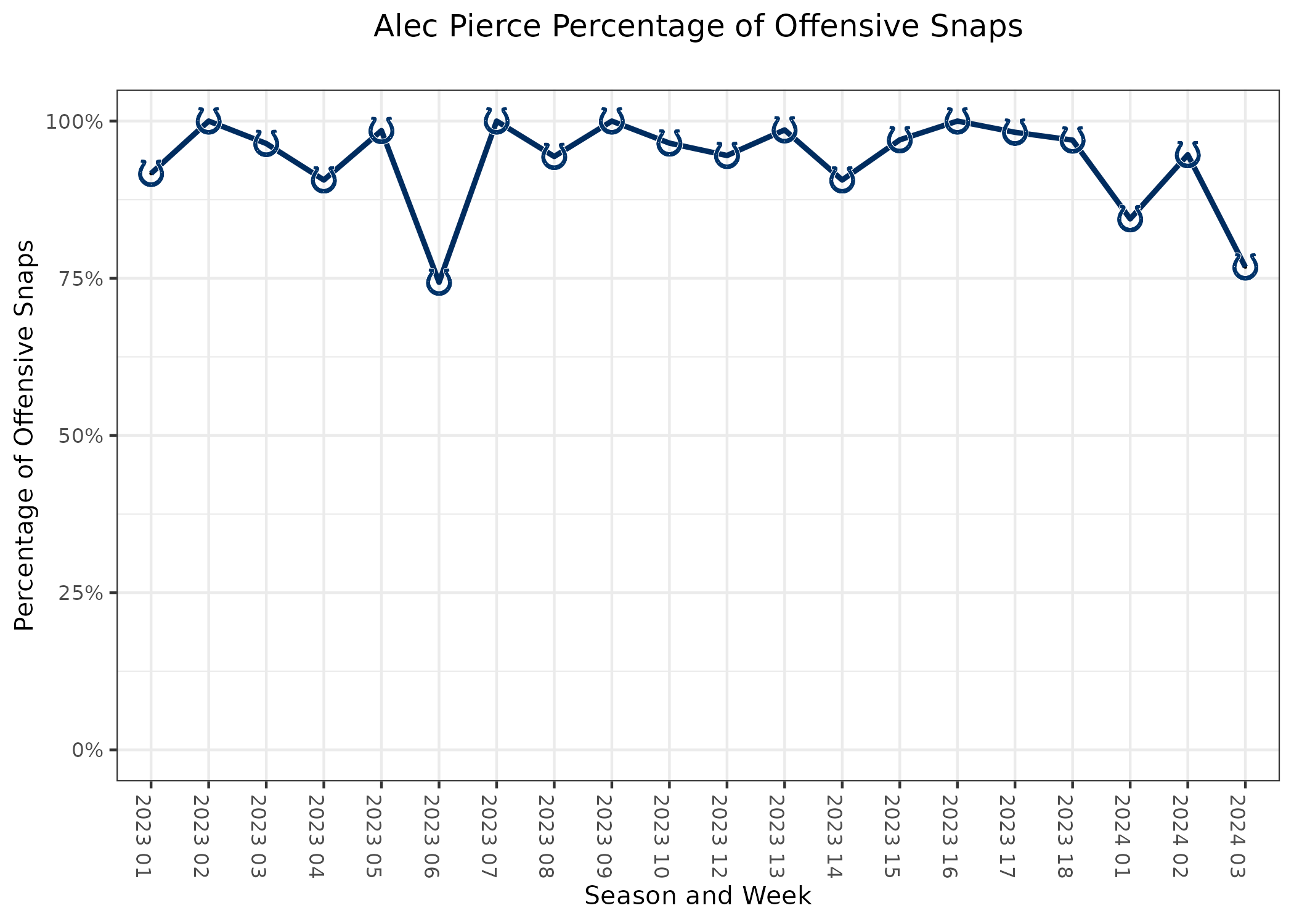
Miscellaneous Notes
- A lot was made last week of Jonathan Taylor not playing in passing situations, which included both the fourth quarter and third downs. This week, the Colts didn’t have any snaps in a two-minute drill. Taylor played in six-of-nine snaps on third downs, up from last week, and the vast majority of all other snaps.
- Bears fullback Khari Blasingame was inactive due to hand and knee injuries.
- Bears receiver Keenan Allen missed a second straight game. He was listed with a heel injury like last week, but also for a personal reason. The Bears did the same thing as last week, allowing Rome Odunze to consistently play in two-receiver sets while DeAndre Carter played in the slot.
- The Bears ran 90 offensive plays, which is by far the most for a team in a game. This included 61 pass plays, which was tied for the most. We should not expect the Bears to have this big of numbers in the passing game going forward unless Caleb Williams significantly improves his efficiency.
Houston Texans @ Minnesota Vikings
- Aaron Jones: 19 carries, 102 yards, 5 receptions, 46 receiving yards, 1 receiving touchdown
- Justin Jefferson: 6 receptions, 81 yards, 1 touchdown
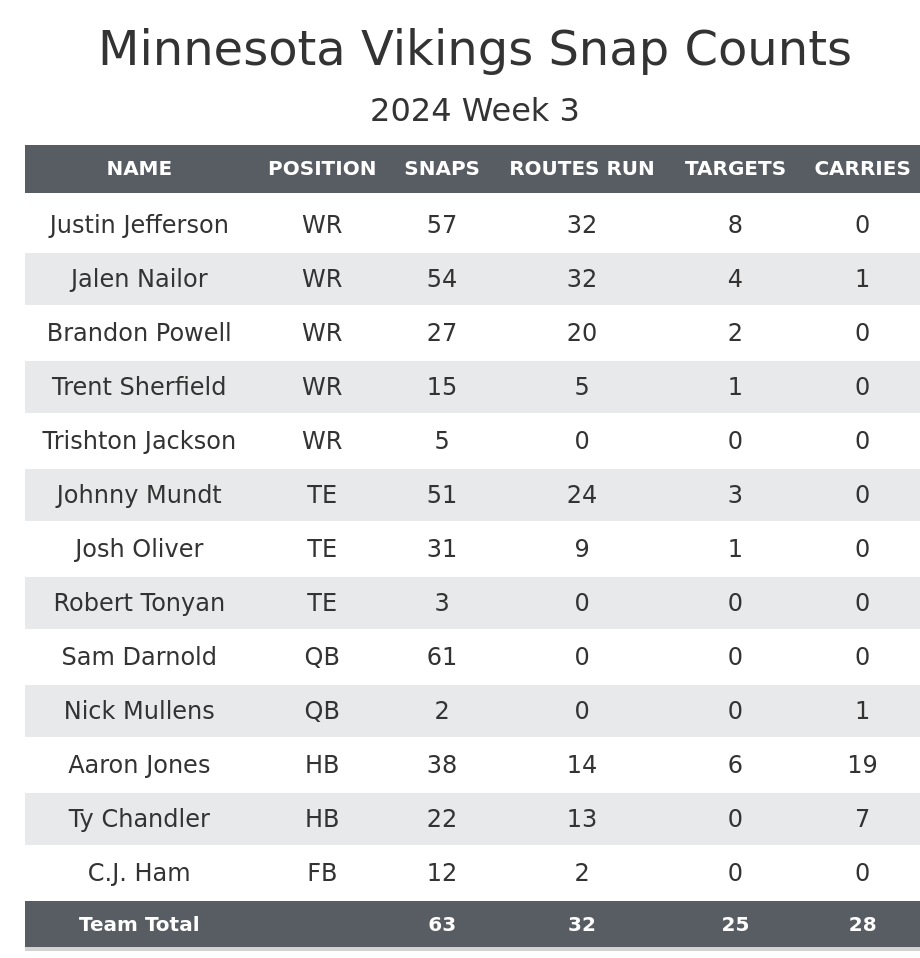
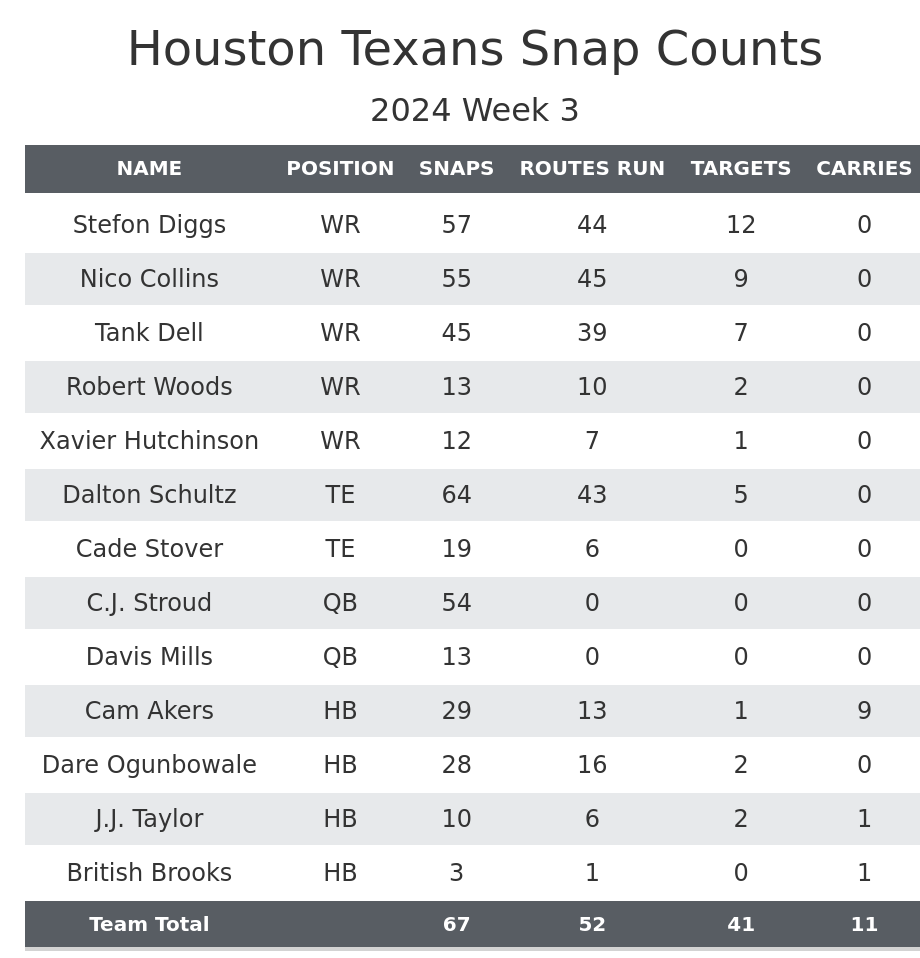
Cam Akers leads the Texans backfield: Dameon Pierce missed his second straight game due to a hamstring injury while Joe Mixon missed due to an ankle injury. Neither practiced this past week.
Akers was clearly the next man up at the end of last week, and that remained the case this week. Dare Ogunbowale was the receiving back like the first two weeks of the season.
Akers played 29 of a possible 32 on first and second downs outside of the two-minute drill in the first three quarters. At that point, the Texans were down 24-7. Ogunbowale continued to play while J.J. Taylor mixed in because the Texans were in clear passing situations and Akers is strictly an early-down back. He ran nine times for 21 yards against a strong Minnesota Vikings defense, but he caught one pass for a touchdown to save his fantasy value.
It’s worth holding onto Akers in case the Texans need him starting for one more week. He should have much more luck against the Jacksonville Jaguars defense.
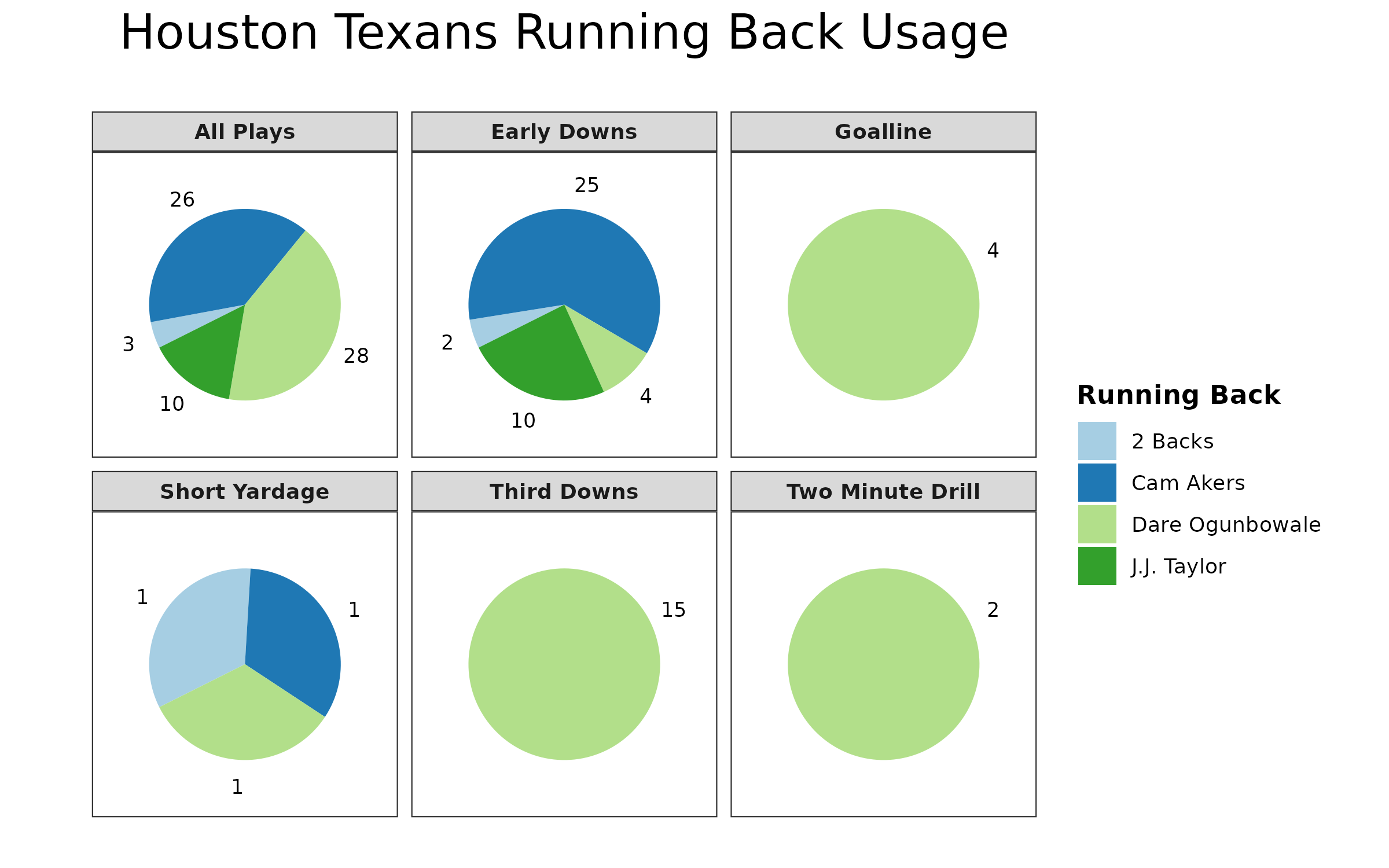
Brevin Jordan lands on injured reserve: The Texans’ backup tight end tore his ACL last week and will miss the rest of the season.
The Texans also lost backup tight end Teagan Quitoriano in the preseason, so their four-man tight end room has turned into two. Rookie Cade Stover has seen slight increases in playing time from one week to the next. In games where the Texans are winning, we can expect a more dramatic increase in snaps for Stover.
The injury meant starting tight end Dalton Schultz played a lot more than usual. He only caught two-of-five passes thrown his way for 11 yards, but we can expect his route percentage to increase going forward. It will still be a little hard to trust him considering Nico Collins, Stefon Diggs and Tank Dell are the primary receiving options, but there is an increased chance Schultz finishes as a top-12 fantasy tight end any given week.
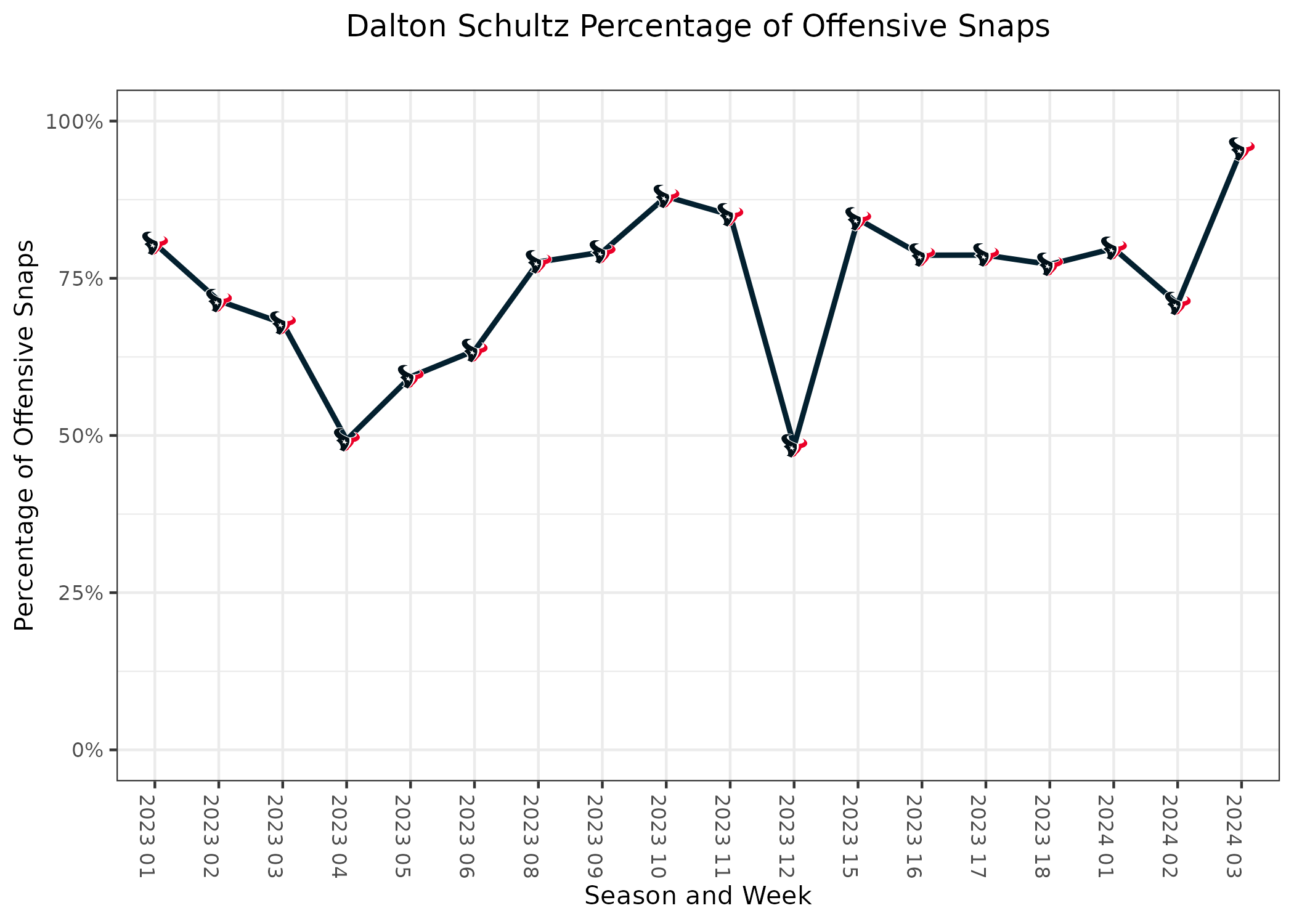
Aaron Jones’ 100-yard game: The Vikings made a slight tweak to when they rotated their running backs, which benefited’ Jones’ fantasy production.
The Vikings have been one of the most consistent teams in their running back rotation. Jones has played between 55-61% of the team's naps each game while Ty Chandler has played 35% of snaps each week.
The difference this week is Chandler was the primary running back in passing situations, including third downs and two-minute drill snaps, while Jones played more of the snaps on early-downs than in the first two weeks. This put Jones in more situations where he received the ball, and Chandler in fewer situations where he would receive the ball. This helped Jones to his best game as a Viking both on the ground and in the air. If this trend continues, it would be a general positive for Jones’ fantasy potential going forward.
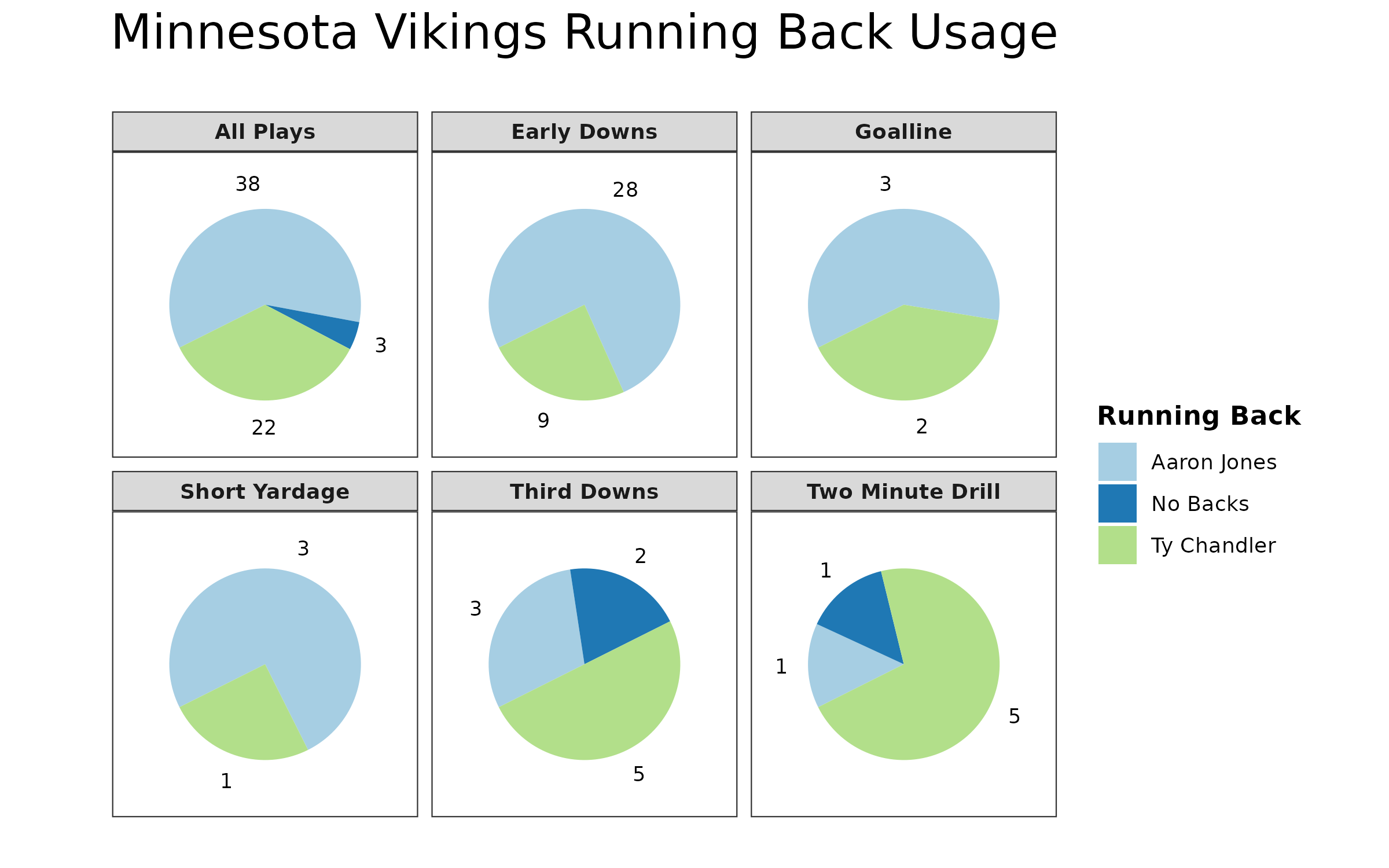
Miscellaneous Notes
- Tank Dell played in three of a possible 19 snaps in two-receiver sets, costing him 11 pass plays.
- Sam Darnold was limping after a hit, which cost him two plays, but he was able to return to the game. It’s worth seeing if he shows up on the injury report this week.
- Jordan Addison missed his second straight game due to injury. Jalen Nailor continued to be his primary replacement, while Brandon Powell continued to play in the slot. Trent Sherfield mostly rotated with Powell in 11 personnel while taking snaps from Jefferson and Nailor in 21 personnel.
Philadelphia Eagles @ New Orleans Saints
- Saquon Barkley: 17 carries, 147 yards, 2 touchdowns
- Dallas Goedert: 10 receptions, 170 yards
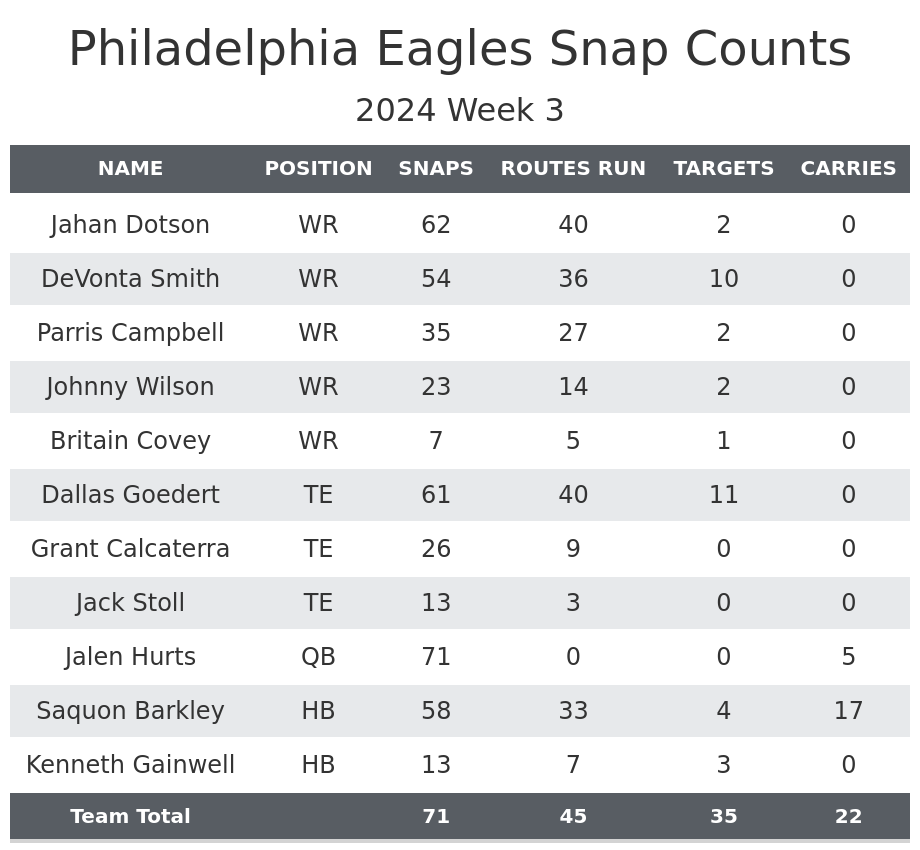
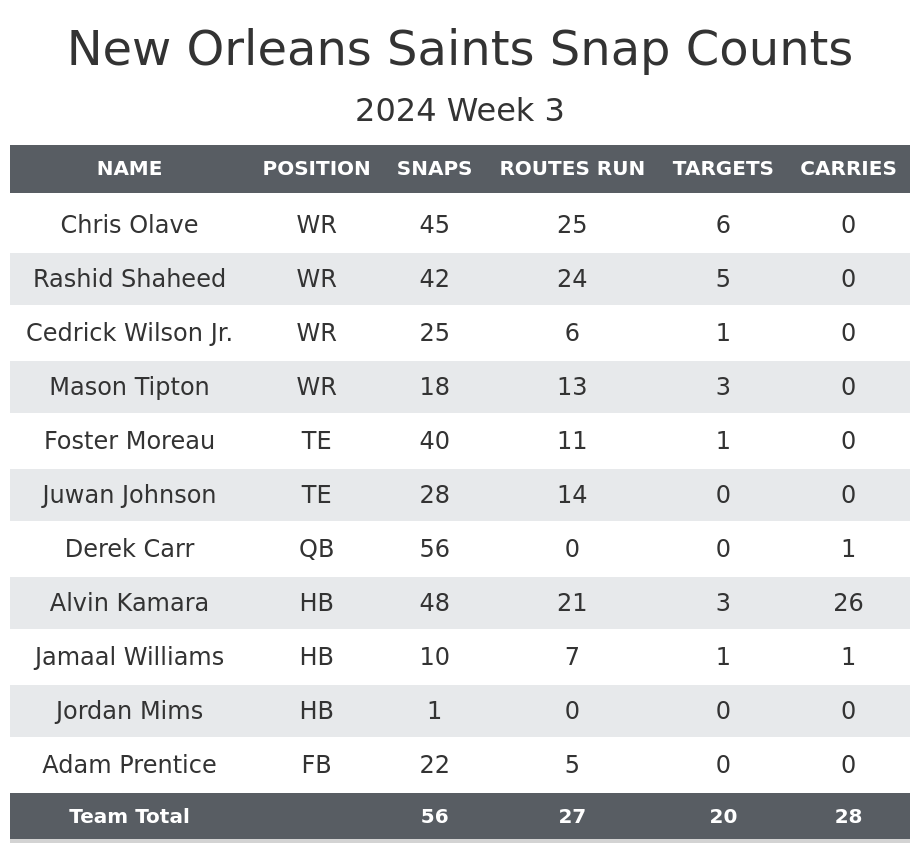
Monitor DeVonta Smith’s health: Smith suffered a helmet-to-helmet hit and was ruled out while being evaluated for a concussion.
The Eagles started the game without A.J. Brown for a second straight week due to a hamstring injury. The good news is rookie Johnny Wilson was healthier this week than last.
Early in the game, Smith and Jahan Dotson were the primary two receivers while Britain Covey was the primary third receiver. Over the first three drives, Smith played all 18 snaps while Dotson played 14, Covey played seven, Johnny Wilson played five, and Parris Campbell played two. At that point, Covey suffered a shoulder injury and didn’t return.
Dotson then started playing an even higher percentage of snaps while Campbell emerged as the clear third receiver. Smith continued to play 100% of his team's offensive snaps until he suffered his head injury. Over the last two drives, ignoring the drive with kneel-downs, both Dotson and Campbell played all 12 snaps, while Wilson played nine of 12 snaps.
It’s not clear who the favorite target would be if the Eagles are missing the three other receivers. Dotson is clearly the receiver most likely to play, but he’s yet to have a decent target share. The main beneficiary is clearly Dallas Goedert, who is a talented tight end whose fantasy value has decreased in recent seasons due to the run-first offense and strength at wide receiver. Without the strength at receiver, Goedert will remain one of the top options at the position.
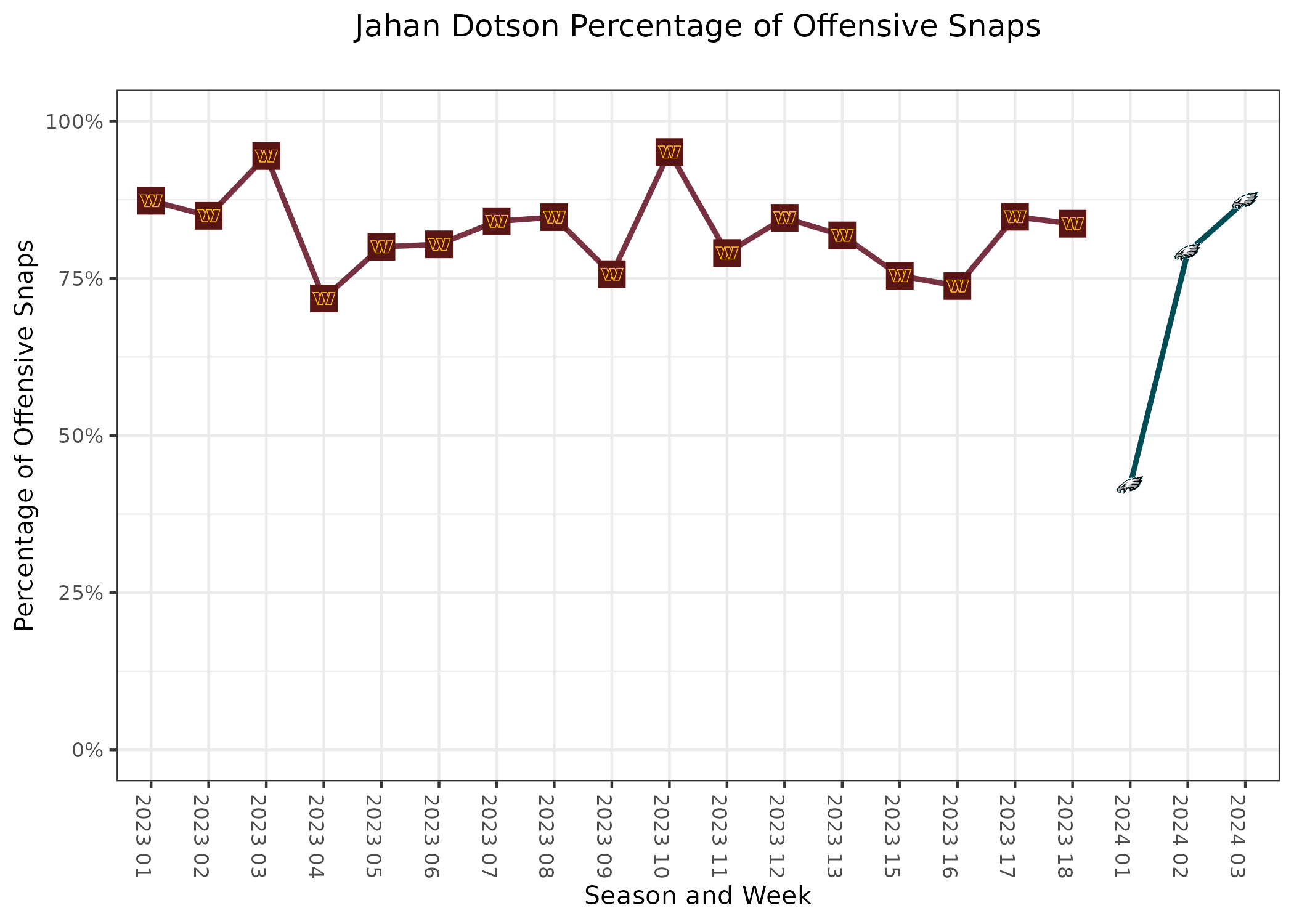
Undrafted rookie Mason Tipton is the Saints' third wide receiver: The former Yale receiver ran the third-most routes and recorded the third-most targets among the wide receivers.
Bub Means had been in contention for the third receiver job, but he was a healthy inactive after playing a significant role the first two weeks. A.T. Perry, who was the third receiver to end last season, was also inactive. He missed the first two games and was listed on the injury report with an illness. This left the Saints with only four active wide receivers.
Tipton started playing snaps last week but that only left him running three routes. This week, the team ran more 11 personnel with Taysom Hill out. Tipton and Cedrick Wilson Jr. split the 11 personnel snaps, but when Tipton was on the field, it was almost always a pass play, while it was more of a mix when Wilson was on the field. The reason Wilson ended up playing more snaps was largely due to his work in 22 personnel as a run blocker.
This doesn’t mean much in the vast majority of leagues, but if you are in a league where almost everyone mentioned in this article is on fantasy rosters, Tipton could be worth considering in case Chris Olave or Rashid Shaheed suffer an injury this season.
Miscellaneous Notes
- Taysom Hill was inactive due to a chest injury.
- Foster Moreau and Juwan Johnson both caught a touchdown in Week 1, but since then, they’ve combined for a two-yard reception on one target over the last two weeks. Considering how much the two are rotated out even while Hill is out, neither should be on fantasy rosters.
- Eagles fourth-round rookie running back Will Shipley hasn’t played an offensive snap since Week 1 and hasn’t played a snap as the only running back on the field.
Los Angeles Chargers @ Pittsburgh Steelers
- Calvin Austin III: 4 receptions, 95 yards, 1 touchdown
- Quentin Johnston: 2 receptions, 44 yards, 1 touchdown
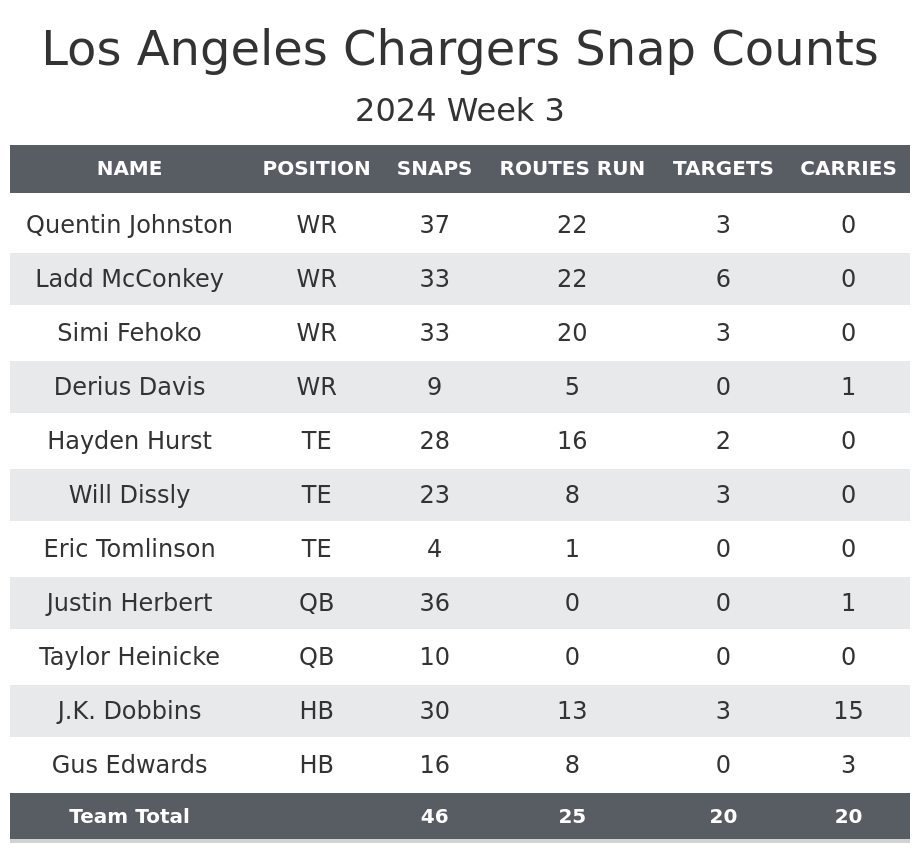
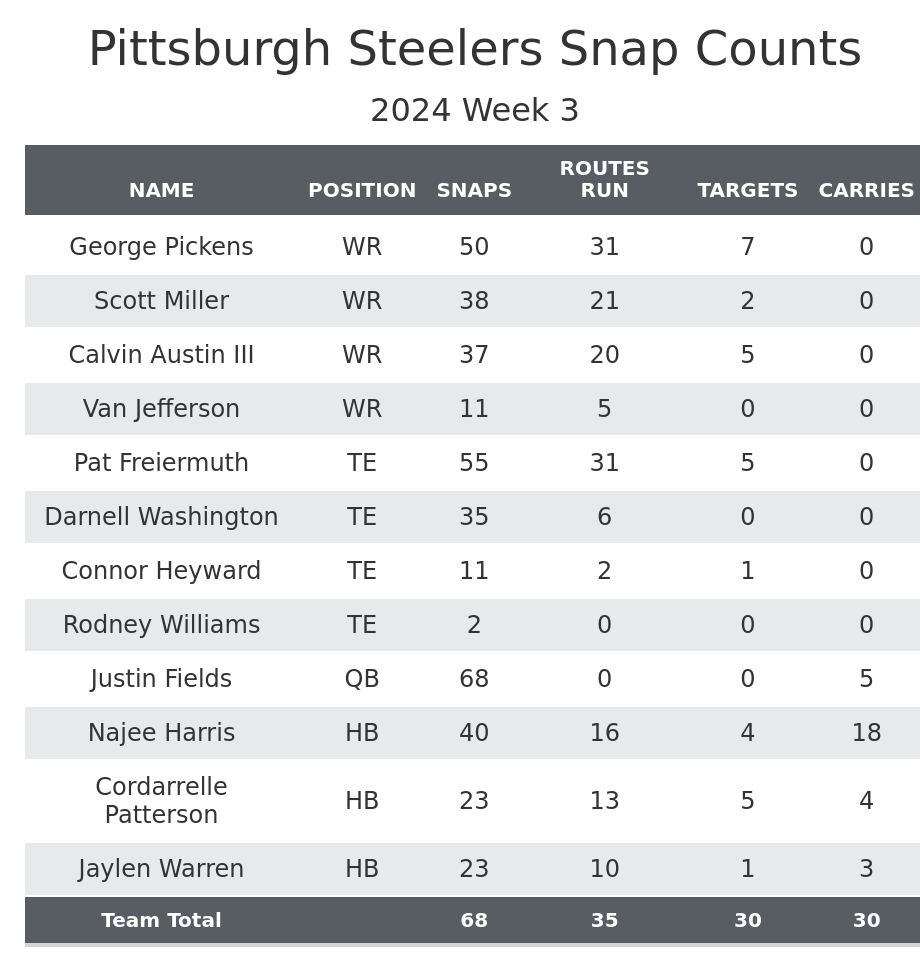
Chargers adjust without Joshua Palmer: The Chargers lead outside wide receiver missed this week due to both elbow and calf injuries.
Palmer didn’t practice all week, but there was some optimism he would play considering he was initially listed as questionable.
This left Quentin Johnston as the Chargers' clear lead outside wide receiver. He was only targeted twice on 20 passes but did catch a touchdown. The Chargers only ran 45 offensive plays in total. Considering he’s scored more in the last two games than he did all of last season while two of his top five games in receiving yards are the last two games, he’s worth targeting off the waiver wire.
Ladd McConkey continued to be the Chargers' primary slot receiver and received more work than usual in two-receiver sets, playing just over 50% of the snaps in those groups. Simi Fehoko surprisingly served as the team’s third wide receiver. He played 75% of his snaps in the slot in the preseason, but in this game, he was primarily playing on the outside. His snap share was similar to the other wide receivers because he was the primary wide receiver in 22 personnel, playing five-of-seven snaps there. This is worth noting in really deep leagues in case Palmer misses another game.
While Brenden Rice was active and a clear outside receiver in the preseason, it looks like it would take at least one or two more injuries for him to play in the near future.
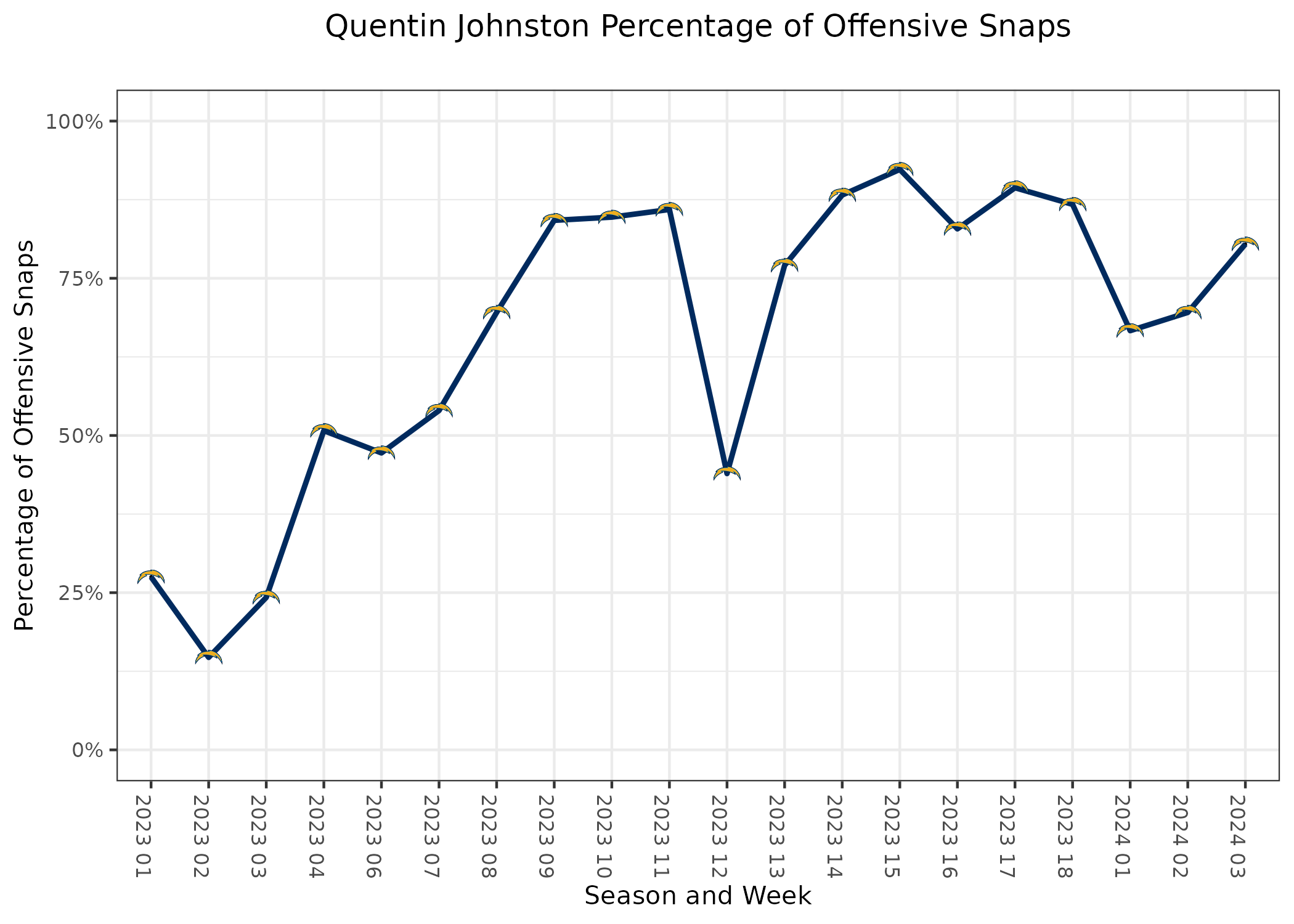
J.K. Dobbins leads snaps for the Chargers: Dobbins played nearly two-thirds of the Chargers' offensive snaps after sharing the backfield with Gus Edwards.
Edwards led the team in offensive snaps in early down situations each of the first two weeks, but this time around, Dobbins was the clear lead running back. In all three games, Dobbins had a clear lead after two drives, and then Edwards would start to get established. This week, Dobbins continued to play the majority of the snaps.
While the Chargers lost by 10 points, the distinction between the two didn’t seem to be game-script related. The Chargers had a lead at halftime and weren’t losing until the fourth quarter. Dobbins was consistently leading in snaps at a 64-67% rate throughout the game. Dobbins’ didn’t have much production in this game while he averaged less than three yards per carry, but this is a pretty clear sign he will continue to be the lead back going forward.
Edwards can be dropped in some leagues because he doesn’t have any standalone value going forward. He is still Dobbins' handcuff, but even if Dobbins suffers an injury, the Chargers would still likely use a committee. This means there are better handcuff options.
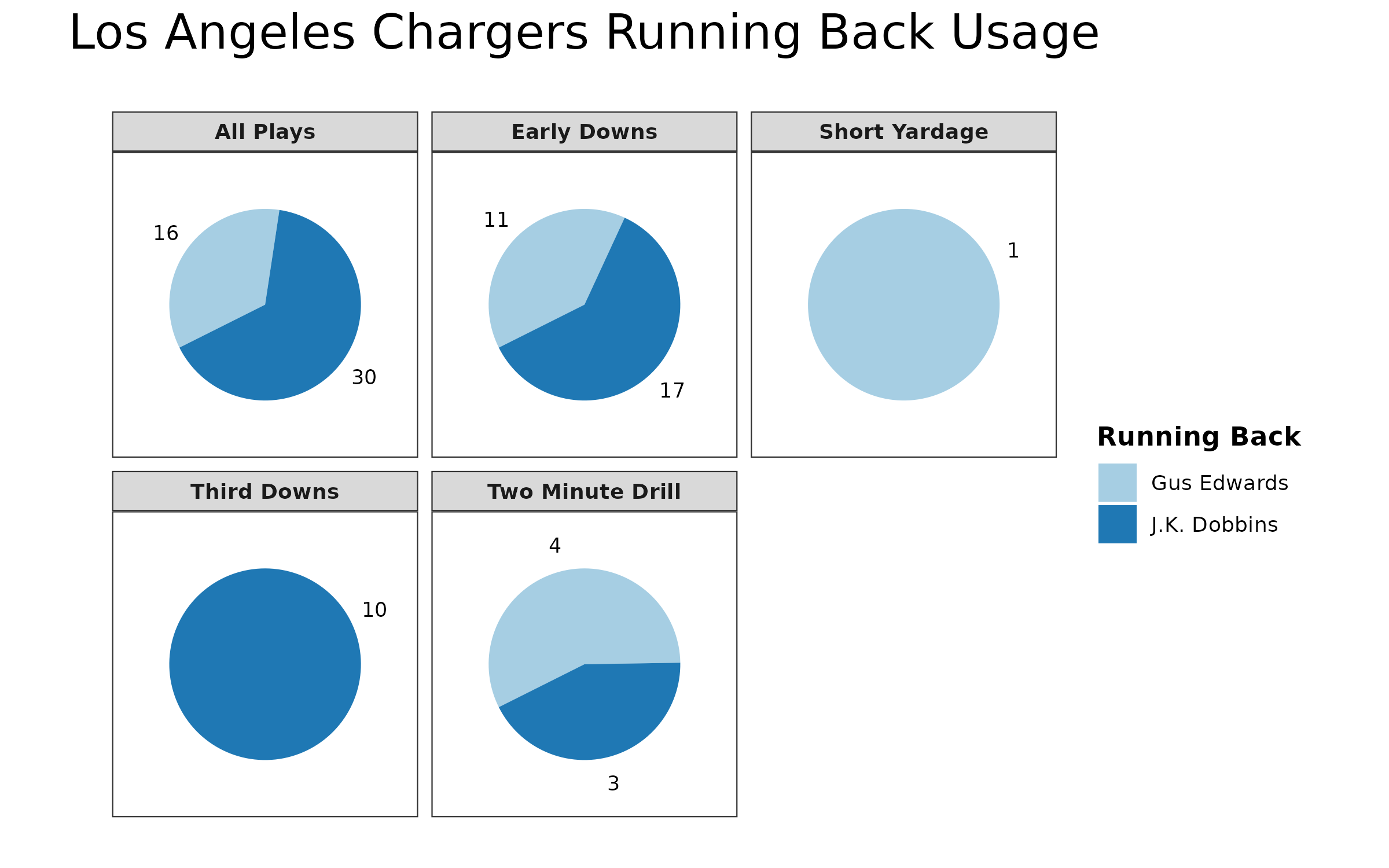
Monitor Van Jefferson’s health: The Steelers starting wide receiver suffered an eye injury and didn’t return.
Jefferson was averaging over 50 offensive snaps per game the first two weeks but only caught three passes for 15 yards as the outside wide receiver opposite George Pickens. Even before the injury, the Steelers made a slight change at wide receiver. Cordarrelle Patterson played three snaps as a true slot receiver in the first quarter, taking playing time away from Calvin Austin III.
Jefferson’s injury occurred on the first play of the second quarter. Scott Miller took over as the outside wide receiver opposite Pickens. Throughout the season, Miller has been the team’s fourth wide receiver, playing significantly with 13 personnel. Patterson continued to mix in throughout the game, primarily at wide receiver, as he only took snaps away from Najee Harris and Jaylen Warren at the end of the game to run out the clock.
An eye injury that takes a player out for an entire game is unusual, so hopefully, it’s not a long-term issue for Jefferson. If he does miss time long-term, we can expect Miller to be the Steelers' starter next week.
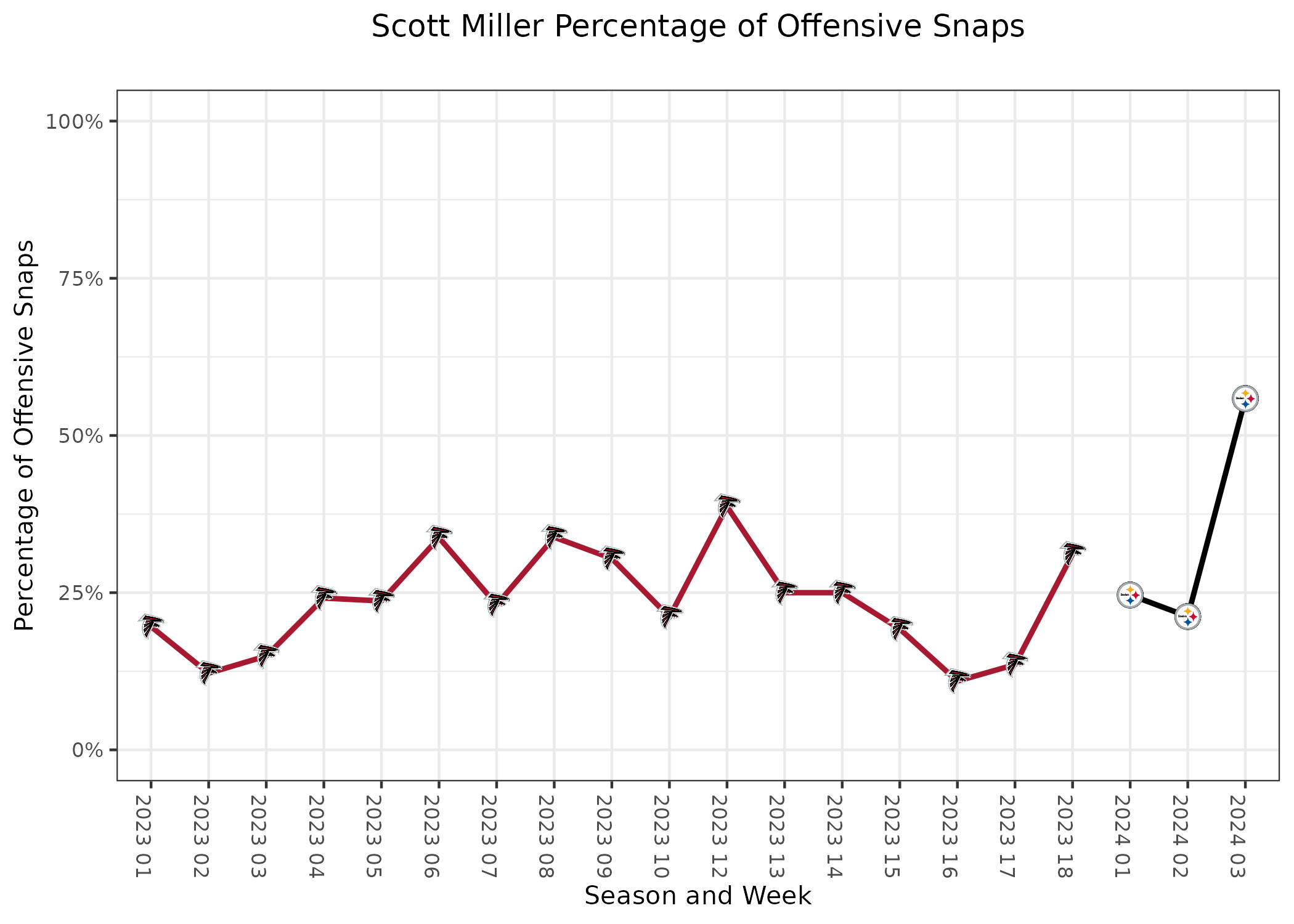
Miscellaneous Notes
- Justin Herbert was questionable for this game due to an ankle injury and in the middle of the third quarter, he seemed to aggravate the injury. He didn’t return with Taylor Heinicke taking over for the rest of the game.
- Roman Wilson was a full participant in practice both Thursday and Friday and wasn’t given an injury status, but he was still inactive. He has yet to play a snap in either the preseason or regular season for the Steelers.
- Steelers blocking tight end MyCole Pruitt was inactive with a knee injury. Connor Heyward replaced him as the third tight end, while Rodney Williams was the team’s fourth tight end.
Denver Broncos @ Tampa Bay Buccaneers
- Chris Godwin: 6 receptions, 53 yards, 1 touchdown
- Courtland Sutton: 7 receptions, 68 yards
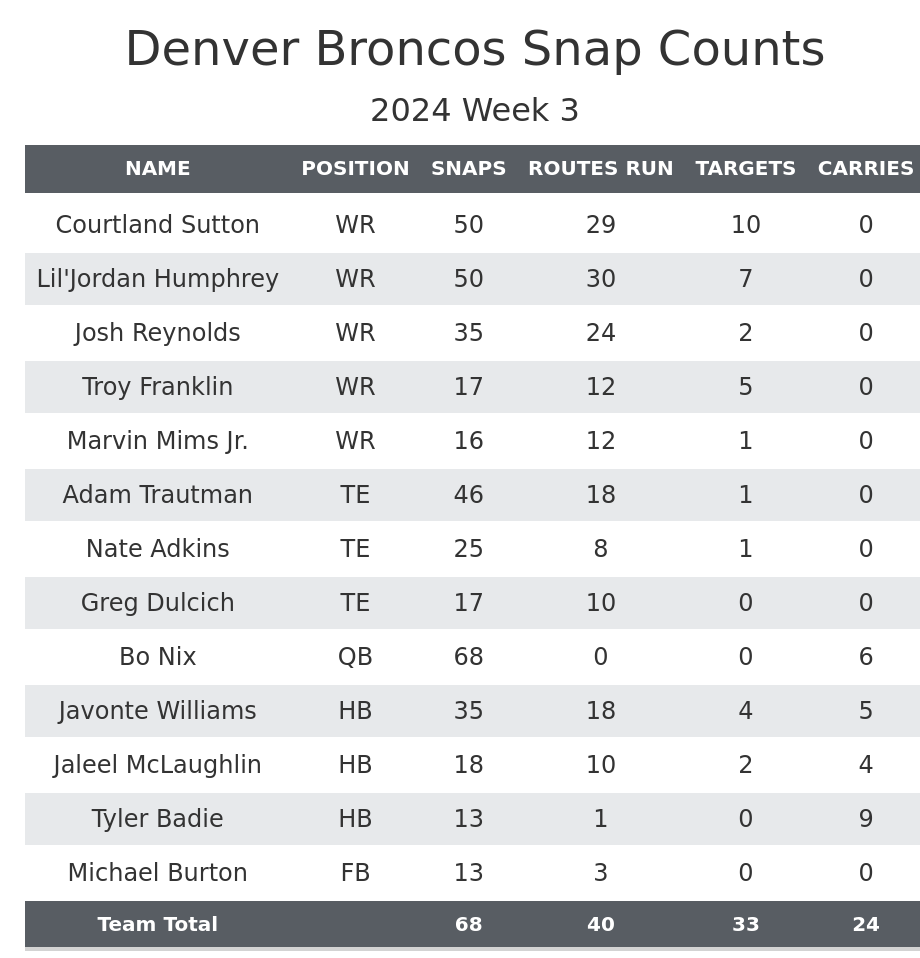
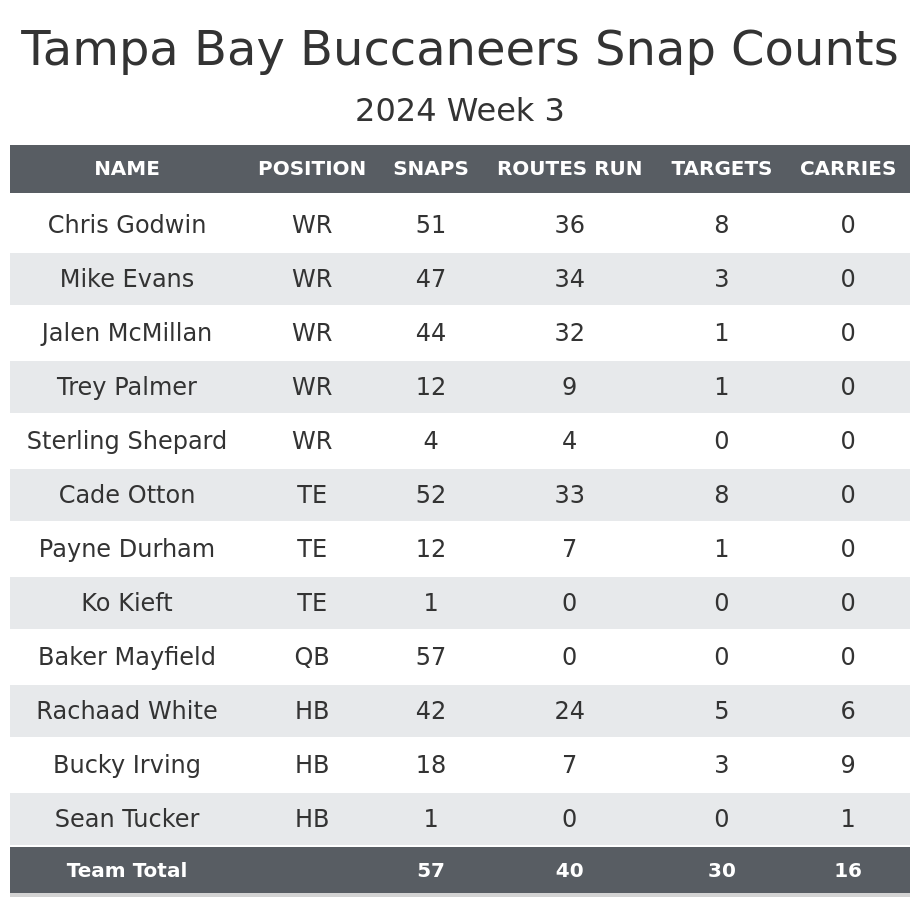
Tyler Badie enters the running back rotation: Badie led the team in rushing attempts and rushing yards.
The Broncos utilized a two-man running back rotation the first two weeks. Audric Estime only played three snaps in Week 1 before landing on injured reserve, and Badie played three snaps in Week 2 as the new third back in the backfield.
This week, Badie played only slightly more often over the first three quarters, playing four snaps on the first 58 plays of the game. Javonte Williams played 35 and Jaleel McLaughlin played 16. The Broncos were up 23-7 with 10 minutes left, so Badie played in nine of the last 10 possible snaps. He ran seven times for 63 yards in the quarter.
While a running back playing in 7% of his team's snaps in the first 50 minutes and 90% in the last 10 minutes of a blowout win should usually not be concerning, it’s worth noting the Broncos have been pretty unpredictable with their usage this season, and Badie played much better than the two other running backs who combined for 19 yards on 10 carries. Badie may mix in a little bit more next week, as he did mix in slightly more early this week. This will make it harder to trust either of the Broncos other running backs.

Bucky Irving leads the Buccaneers in rushing attempts: White led the team in rushing yards and yards per carry each of the first two weeks.
The Buccaneers haven’t made any significant changes to when their running backs are on the field through the first three weeks. White is clearly leading in most situations. This was the first time we’ve seen them in true two-minute drill situations, and Irving played a decent amount there.
The difference is the Buccaneers have become more and more likely to give Irving the ball when he’s on the field and less likely to give it to White when he’s on the field. Through three weeks, Irving has 25 carries for 154 yards, while White has 31 carries for 67 yards.
At this point, White is still the better option in PPR leagues because White is catching more passes, but that might not last for much longer. Irving remains one of the top waiver wire options because it wouldn’t be surprising if Irving eventually leads the team in offensive snaps on early downs.
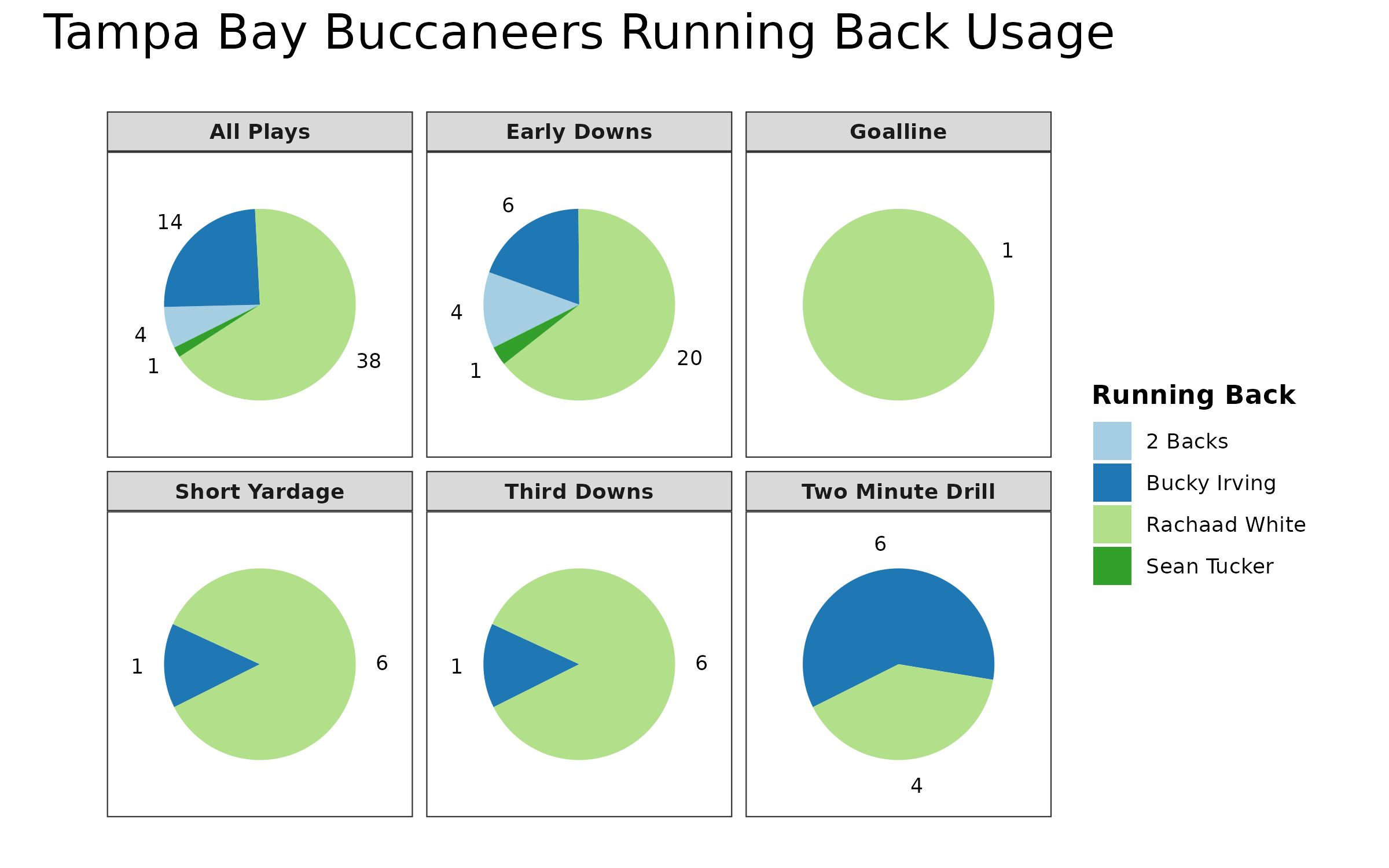
Miscellaneous Notes
- Buccaneers rookie wide receiver Kameron Johnson was inactive due to an ankle injury, leading Sterling Shepard to be the Bucs' fifth wide receiver.
- Lil’Jordan Humphrey ran more routes and saw more targets than Josh Reynolds. Still, it’s worth noting Reynolds was on the injury report due to an Achilles injury, which likely limited his playing time. It’s also possible Humphrey is the Broncos' second wide receiver for Denver going forward.
- Similarly, Greg Dulcich was on the injury report due to both a knee and ankle injuries, potentially limiting his time. The game script also could have heavily influenced Dulcich’s playing time. It will be hard to start him unless the Broncos are heavy underdogs.
- Devaughn Vele was a limited participant on Wednesday and a full participant on Thursday and Friday. He wasn’t given an injury designation, but he was inactive. This was particularly surprising after he caught eight passes in Week 1.
Green Bay Packers @ Tennessee Titans
- DeAndre Hopkins: 6 receptions, 73 yards, 1 touchdown
- Emanuel Wilson: 12 carries, 50 yards, 2 receptions, 35 receiving yards, 1 receiving touchdown
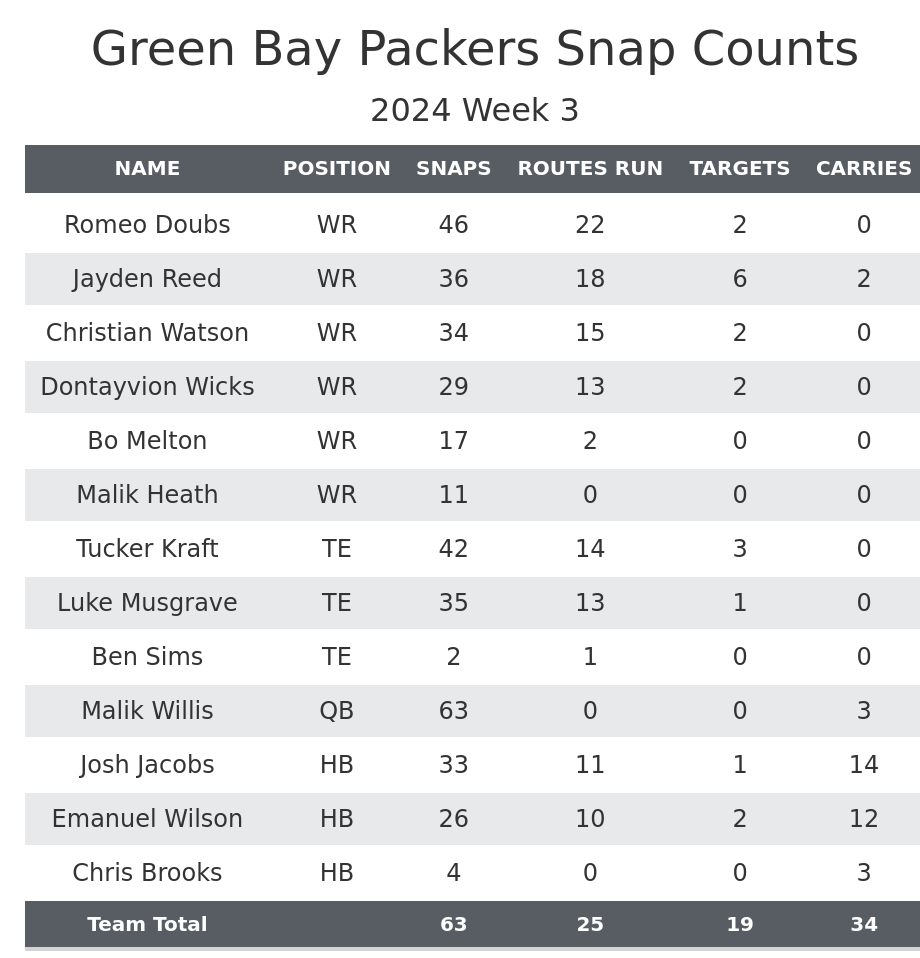
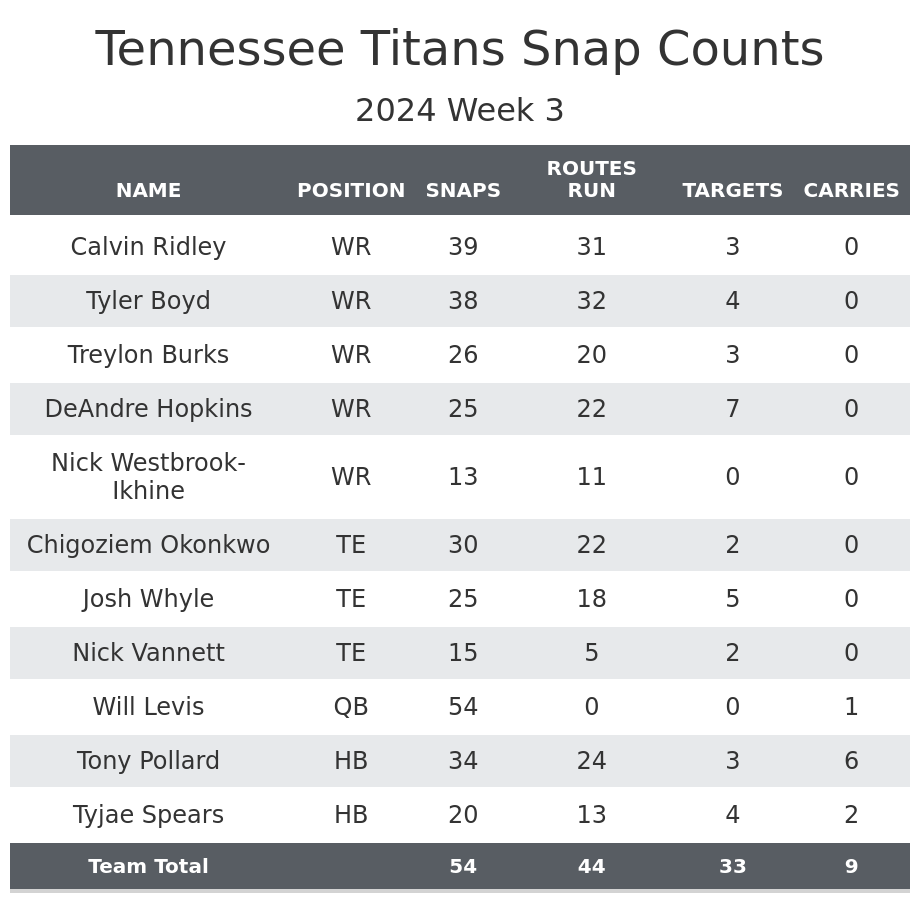
DeAndre Hopkins re-emerges: Hopkins’ playing time has been limited due to a knee sprain, leading him to a quiet Week 1 and 2.
Hopkins played 27% of Tennessee's offensive snaps in Week 1 and 44% in Week 2, coming away with just one catch for single-digit yards in each game. Whenever he was off the field, Treylon Burks was typically on the field.
This week, Hopkins played slightly more. He was at 52.6% of his team's offensive snaps at halftime, but the Titans were down two scores at halftime and three scores by the middle of the third quarter, so he started rotating out more. Instead of Burks losing significant snaps, he was in a three-man rotation with Hopkins and Calvin Ridley. Ridley had played over 82% of the Titans' offensive snaps, but that was down to 72% this week, including double-digit pass plays where Ridley wasn’t on the field. This makes it clear that Burks will remain a part of the Titans’ offensive game plan despite how much they invested in Hopkins and Ridley the last two offseasons.
There is still room for Hopkins to see a higher percentage of offensive snaps. He was typically playing 75% of snaps last season. Hopkins also hasn’t shown up on the injury report in the last two weeks, so this may be the new normal for the 32-year-old receiver. If this is normal, it’s going to be very difficult to trust Hopkins in fantasy starting lineups.
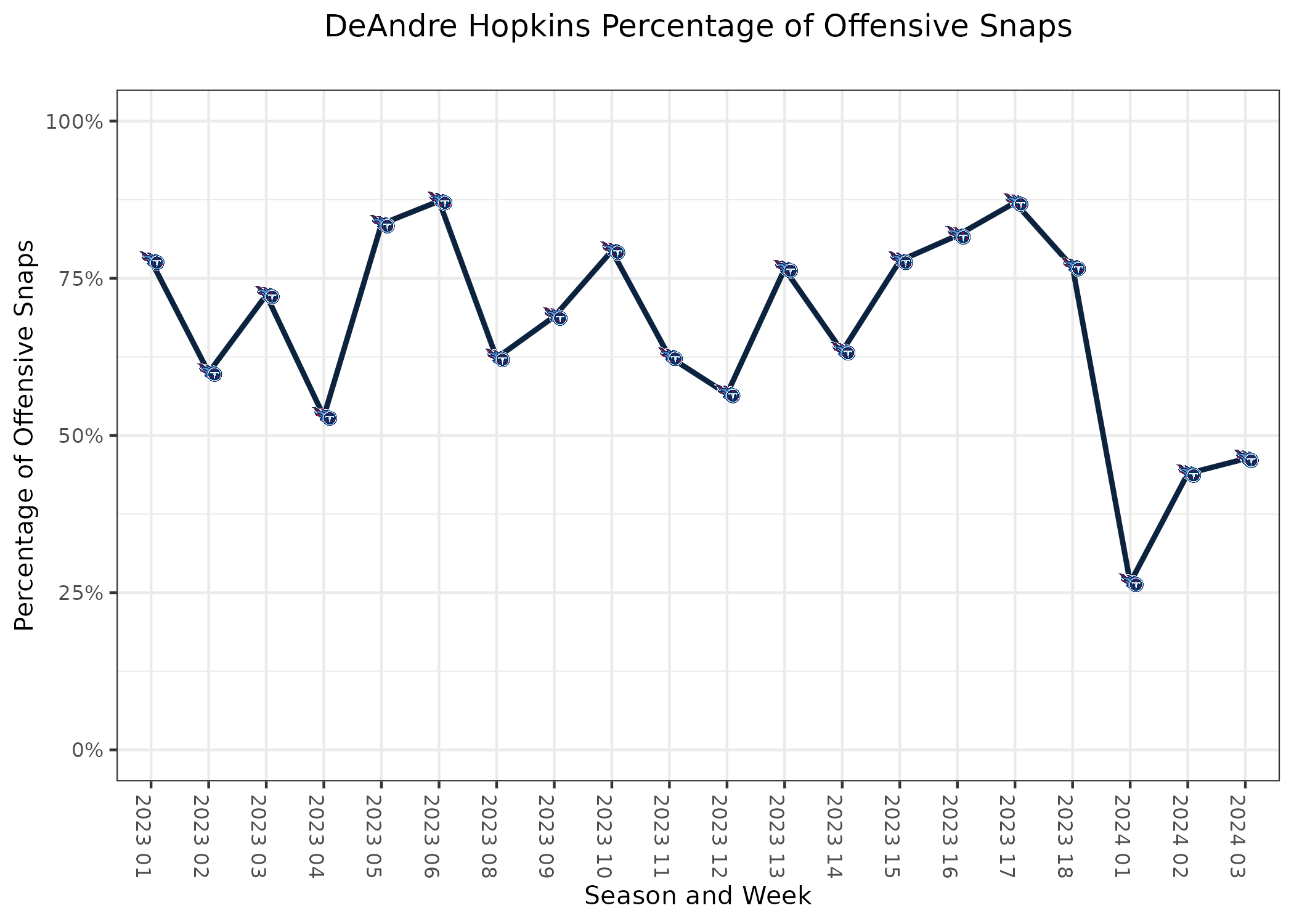
Tyjae Spears’ leads the Titans backfield in fantasy points: The Titans abandoned the run early, allowing the better receiving back to score more fantasy points.
The Titans backfield has looked a little different each week. The first week, the Titans rotated more by situation, while Tony Pollard was the clear back in rushing situations and Spears in passing. In Week 2, Spears ended up with more snaps in the first half but then suffered an injury.
This week, it was mostly a rotation by drive. Pollard had five drives compared to Spears' three. In the three drives where both players were on the field, Pollard played 12 snaps to Spears' 10. While Spears scored more fantasy points this week, Pollard is still the running back to consider in fantasy starting lineups. The fact that the Titans have changed how these running backs have rotated each week does add some volatility here and opens the door for Spears to earn more time going forward.

Emanuel Wilson leads the Packers backfield in fantasy points: Wilson gained more yards than Josh Jacobs on the ground and in the air.
Packers rookie running back MarShawn Lloyd was set on injured reserve this week, which made it clear Wilson was the Packers' second running back this week.
Jacobs dominated snaps in the first quarter, playing 12-of-16 snaps, including five carries. The Packers were up by 10 points at this point, which led the two to see a pretty even split over the rest of the game. Half of Wilson’s carries occurred in the fourth quarter.
The Packers likely wanted to give Jacobs at least some rest. As of the end of the early window, Jacobs had the league lead in carries this season when including plays called back by penalty. Considering the Packers were already down two of their top three running backs, it’s understandable they want to avoid Jacobs getting injured or overworked. Had this game been closer, we probably would have seen Jacobs taking a higher percentage of snaps.
It’s fine to pick up Wilson as the handcuff to Jacobs, but it’s unlikely Wilson will have standalone fantasy value unless the Packers are in another decisive victory.
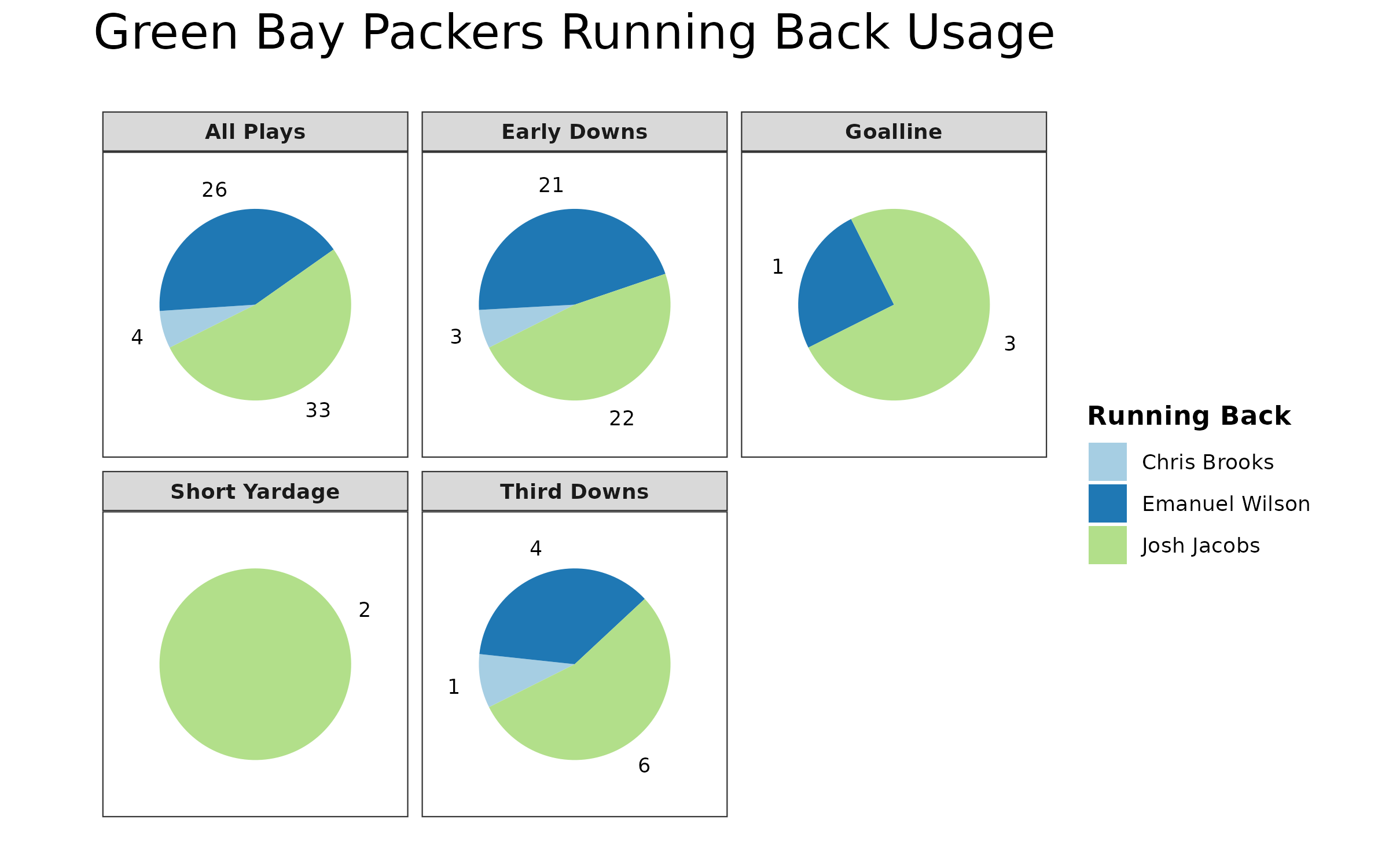
Miscellaneous Notes
- The Titans' tight end room remains one to avoid. Chigoziem Okonkwo ran the most routes, while Josh Whyle had the most receptions and yards, and Nick Vannett scored a touchdown. None of them ran a route on over 50% of the Titans' pass plays.
- Packers tight end Tucker Kraft missed some time in the third quarter due to a shoulder injury, but he was able to return and kept playing despite the Packers' multiple-score lead. He still only ran a route on 11-of-18 pass plays in the first half compared to Luke Musgrave‘s eight-of-18.
- The Packers wide receiver rotation hasn’t changed over the last three weeks. Primarily, it’s Romeo Doubs in one spot, Christian Watson and Dontayvion Wicks rotating for the other, and Jayden Reed playing in the slot in 11 personnel. Reed has yet to play any of the 52 snaps in 12 personnel this season.
Carolina Panthers @ Las Vegas Raiders
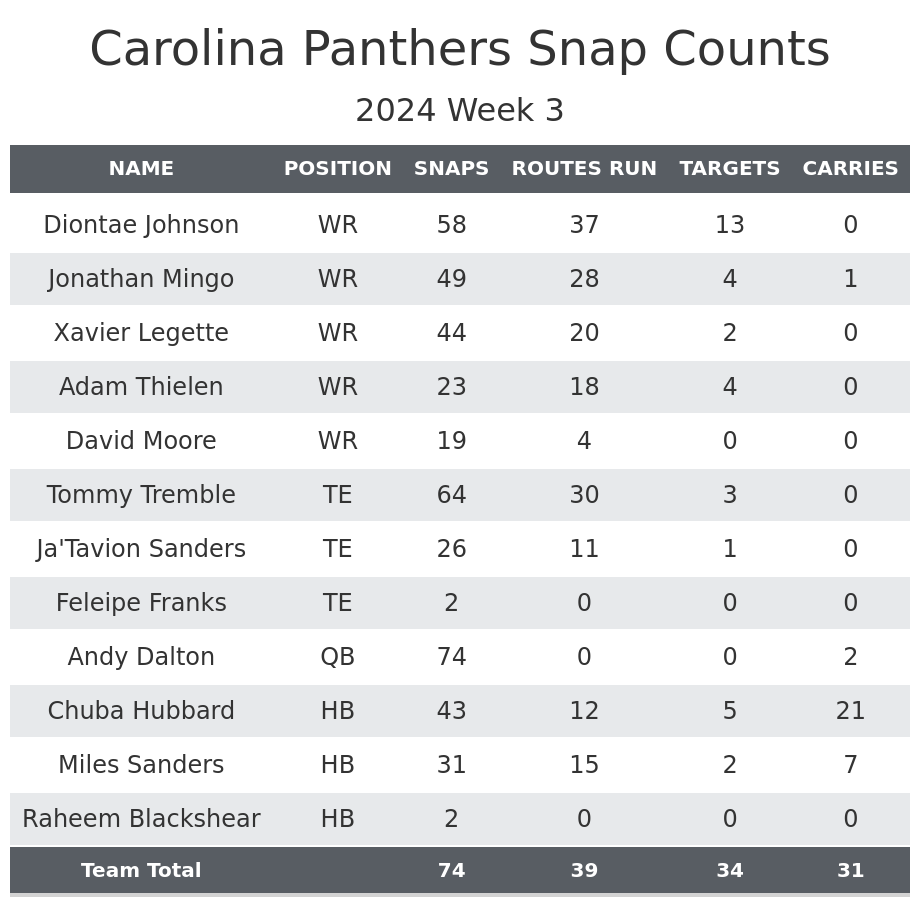
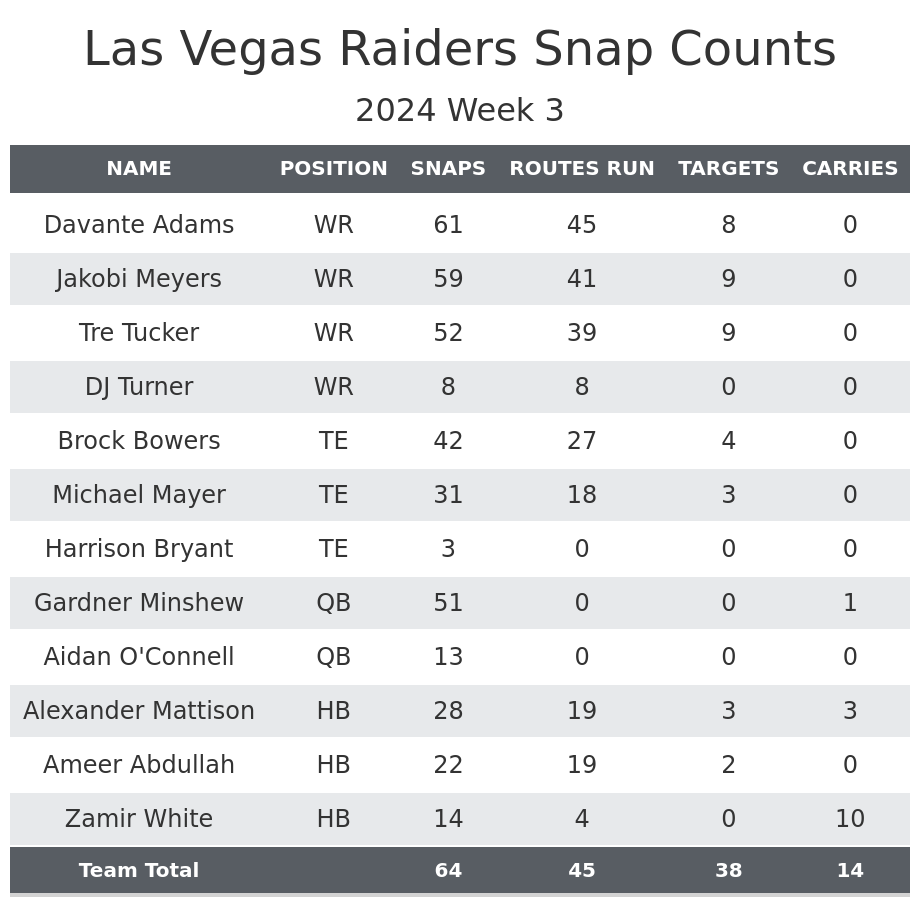
Monitor Adam Thielen’s health: Thielen suffered a hamstring injury on a 31-yard touchdown catch and didn’t return.
The Panthers started the game with a new quarterback — Andy Dalton. They made a slight change to their wide receiver rotation. Diontae Johnson, Thielen and Jonathan Mingo remained the primary players in 11 personnel, but in 12 personnel, the team consistently used Johnson and Xavier Legette. This meant less playing time for Thielen even before he suffered his injury.
After Thilen’s injury, Legette played much more in 11 personnel. It also left David Moore rotating in more in 11 personnel, which was a clear sign the Panthers were going to run the ball. Thielen has been the primary slot receiver, but this change moved Mingo to the slot.
If the Thielen injury is serious, Legette would see a significant increase in snaps. He had a career-high in receiving yards at 42, which isn’t saying much, but this offense looks much improved with Andy Dalton at quarterback. Legette may become the clear second receiving option sooner rather than later.
Sell high on Chuba Hubbard: The Panthers lead running back had the best game of his career but remains part of a rotation that could get more complicated.
The Panthers have made changes at several other offensive positions over the first three weeks, but the running back situation has remained consistent. Hubbard has led a two-man rotation where Hubbard gets the ball more often when he’s on the field. Hubbard had a clear lead in snaps on the first three drives before Sanders played every snap on the following three drives. Hubbard led the way in the second half to close out the victory.
Hubbard's performance this week was largely due to the quarterback change and opponent and not to do with his role. The biggest problem is after Week 4, rookie Jonathon Brooks is eligible to return from the NFI list. Chances are Brooks will get eased into action rather than winning the starting job immediately, but more snaps for Brooks will likely mean fewer snaps for Hubbard. It’s better to move on now rather than wait for more people to talk about Brooks' return.
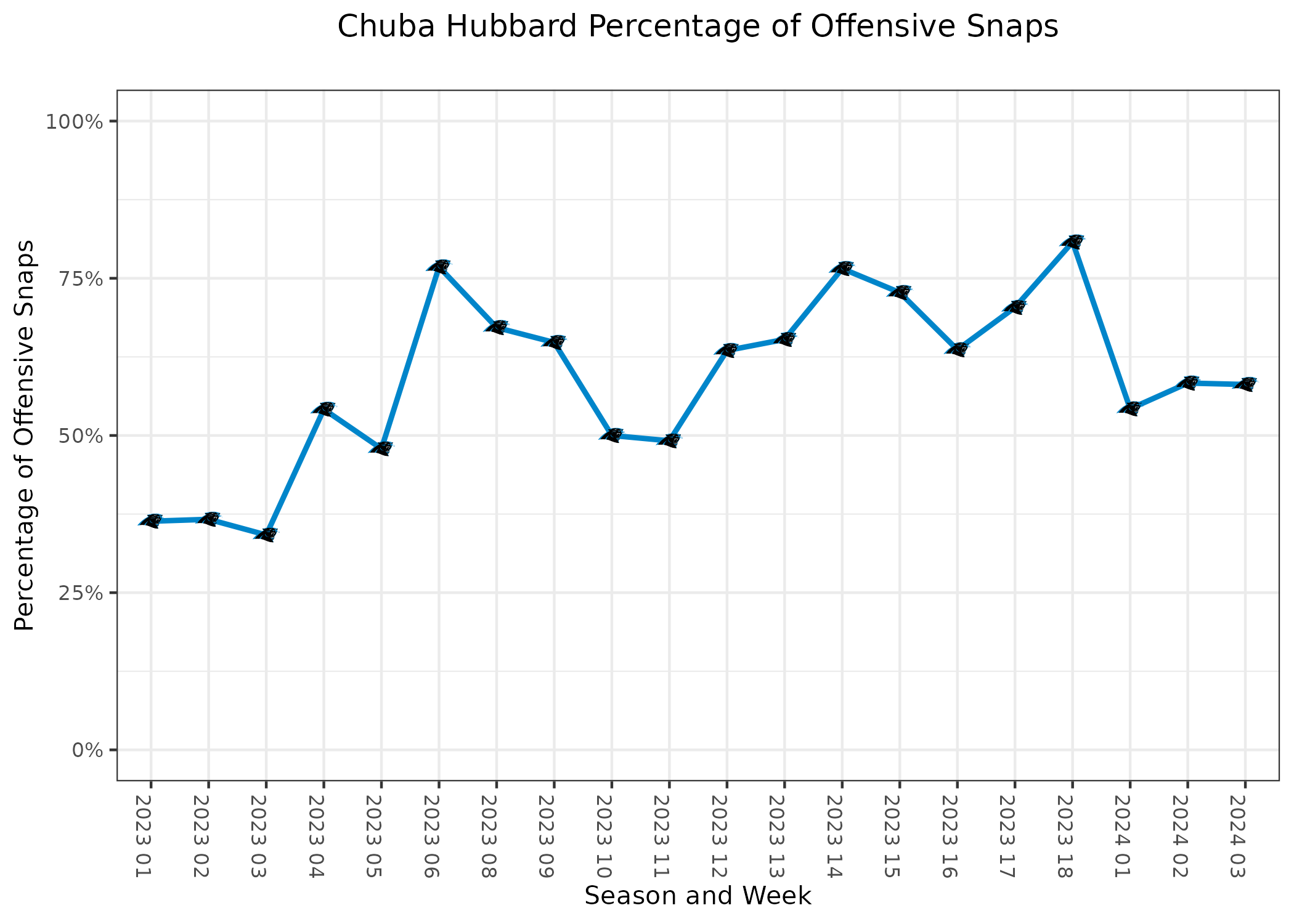
Zamir White finishes third among Raiders running backs in snaps: The Raiders quickly abandoned the run in their blowout loss.
When the Raiders first received the ball, they were down by a touchdown. White ran twice for six yards, which was followed by an incomplete pass and punt by the Raiders. On the second drive, White ran another four times and the drive ended with an Alexander Mattison goal-line run. Mattison and White have split goal-line work 50/50 this season. On the third drive, he ran twice more for three yards.
White didn’t play a snap on the following three drives because they all occurred in the last six minutes of the first half, and the Raiders spent that time passing. The Raiders got the ball to start the second half. He ran twice for four yards, leading to another punt. By the time the Raiders got the ball again, they were down 20 points with 20 minutes left and went with Mattison and Ameer Abdullah the rest of the way. White only played two of a possible 29 snaps in those 20 minutes.
It’s clear the Raiders want to run the ball, but White has averaged 3.3 yards per carry and has two first downs over three games. If the Raiders are favorites to win a game, it’s fine to consider starting White, but they will need to be winning a game for White to have any fantasy value.

Miscellaneous Notes
- Tommy Tremble took over as the Panthers' clear lead tight end. He missed Week 1 and split time with rookie Ja’Tavion Sanders in Week 2. Ian Thomas is on injured reserve but could return to make this rotation even less attractive.
- Tre Tucker had the best game of his NFL career with seven receptions for 96 yards and a touchdown. He only had one other game with more than three receptions. While he might be a waiver target in deeper leagues, he’s the clear fourth option on most plays.
- Brock Bowers playing time has been incredibly consistent, playing 66-68% of his team's offensive snaps each week.
Miami Dolphins @ Seattle Seahawks
- Zach Charbonnet: 18 carries, 91 yards, 2 touchdowns, 3 receptions, 16 receiving yards
- D.K. Metcalf: 4 receptions, 104 yards, 1 touchdown
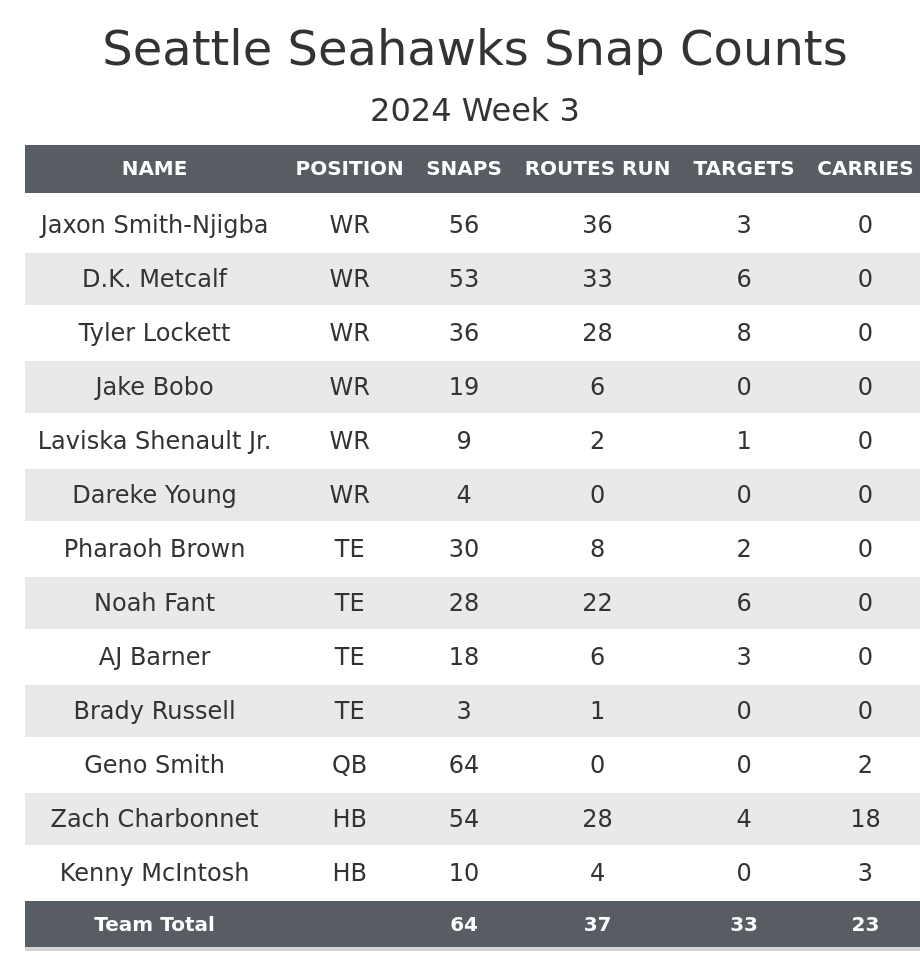
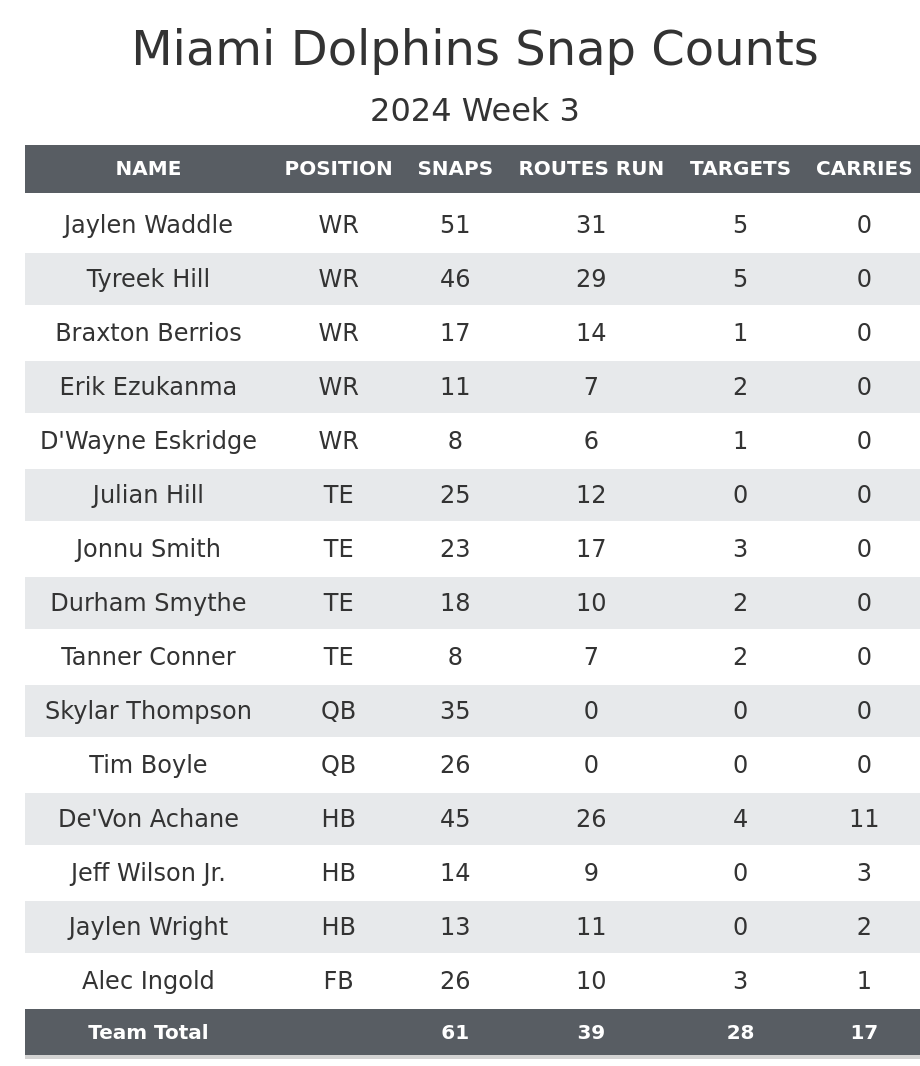
Good news and bad news for Noah Fant: He caught six passes for 60 yards, which was his best game since 2021.
Fant was in a three-man rotation at tight end last season, making it impossible for him to be fantasy-relevant in his limited playing time. He played at least 75% of Seattle's offensive snaps in the first two games, which was very promising. He wasn’t seeing many targets, but he was also coming off an injury during training camp, and this is a new offense for him. The good news is he received more targets and put up solid fantasy production this week.
The bad news is Pharaoh Brown, who missed the first two weeks, was active for this game. Brown played significantly in 11 personnel and also kept Fant out of 12 personnel. The Seahawks have used 11 personnel on 75% of their snaps this season and that rate remained high this week despite the blowout, but it still left Fant off the field for over 40% of the pass plays of this game.
In future games that are closer, Fant should get closer to a 70% route rate, but it looks like Brown will prevent Fant from being a clear and obvious tight end target for the rest of the season.
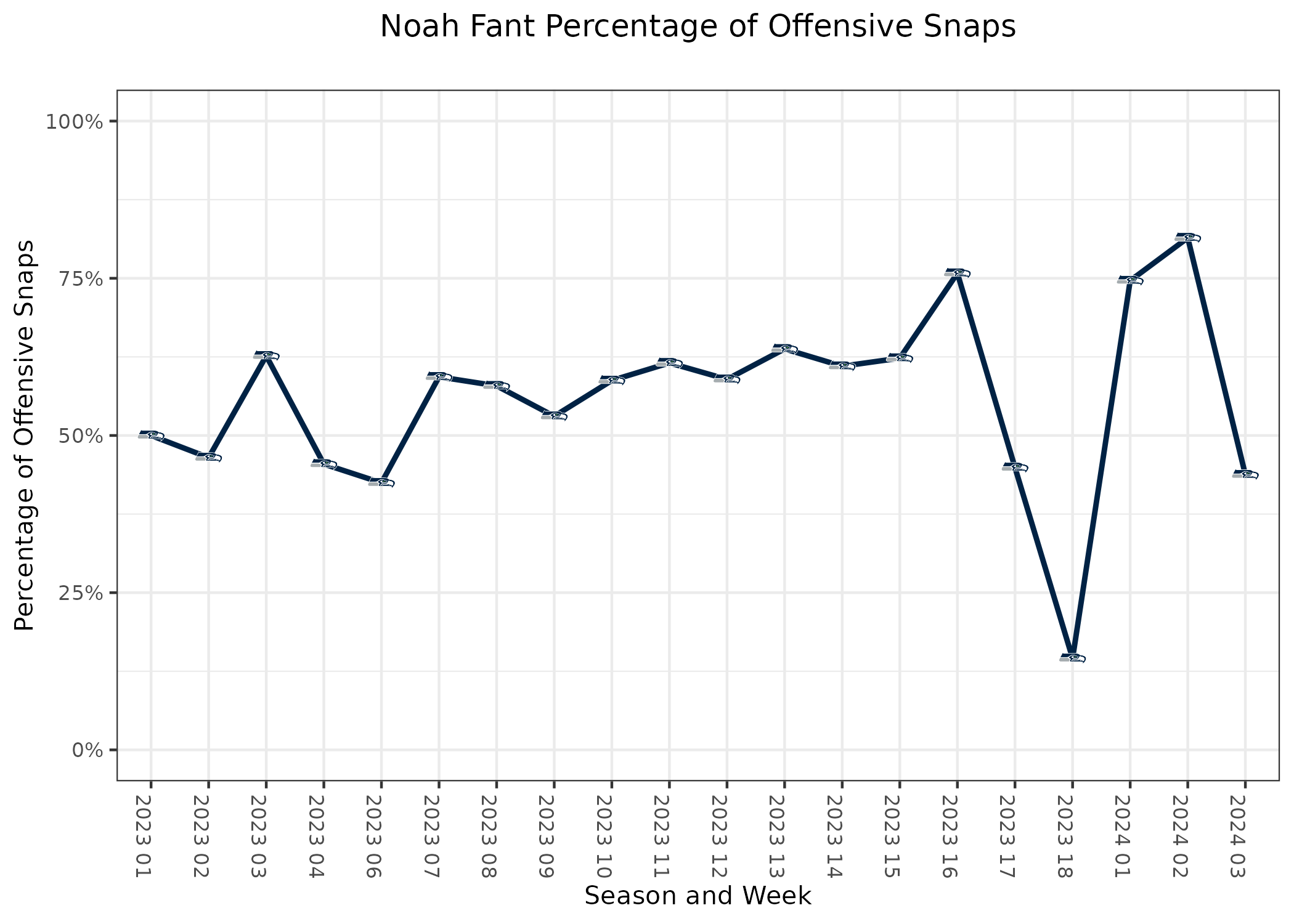
Buy low on Jaxon Smith-Njigba: While Smith-Njigba didn’t have as much production as the other Seahawks’ skill players, his playing time remains on the rise.
Smith-Njigba had the best game of his NFL career last week, and he followed that up with a three-catch, 39-yard performance. The Seahawks scored on three of their first four drives and didn’t do much over the rest of the game.
Smith-Njigba’s playing time continues to be on the rise. He played 47-of-50 snaps in 11 personnel and nine-of-13 in 12 personnel, which led all wide receivers on the team in both groups. These rates keep getting higher despite Tyler Lockett theoretically getting healthier. Lockett has generally remained limited in practice, but he didn’t play a single snap in 12 personnel. Both Jake Bobo and Dareke Young were the backups in that personnel grouping.
The Seahawks have one of the best offenses, and Smith-Njigba appears to be one of the top weapons. This is likely the easiest it will be to trade for him for the rest of the season.

De’Von Achane leads the Dolphins backfield again: Raheem Mostert missed his second straight game due to a chest injury.
Achane shined last week without Mostert with 22 carries for 96 yards and seven receptions for 69 yards. He played an even higher percentage of the Dolphins’ offensive snaps this week, but it didn’t lead to the same production.
The Dolphins only ran 56 offensive plays. Achane was the primary ball carrier or target for 28 of them. The game script made it harder for Miami to stick to the run. Despite the game script, fullback Alec Ingold was still on the field significantly, as half of his snaps came in the second half.
Luckily, the Dolphins schedule gets easier. Over the next five weeks, the Dolphins face four teams with a losing record and have their bye week. This should allow Miami to stick with the run more over the next month, making Achane another buy-low candidate.
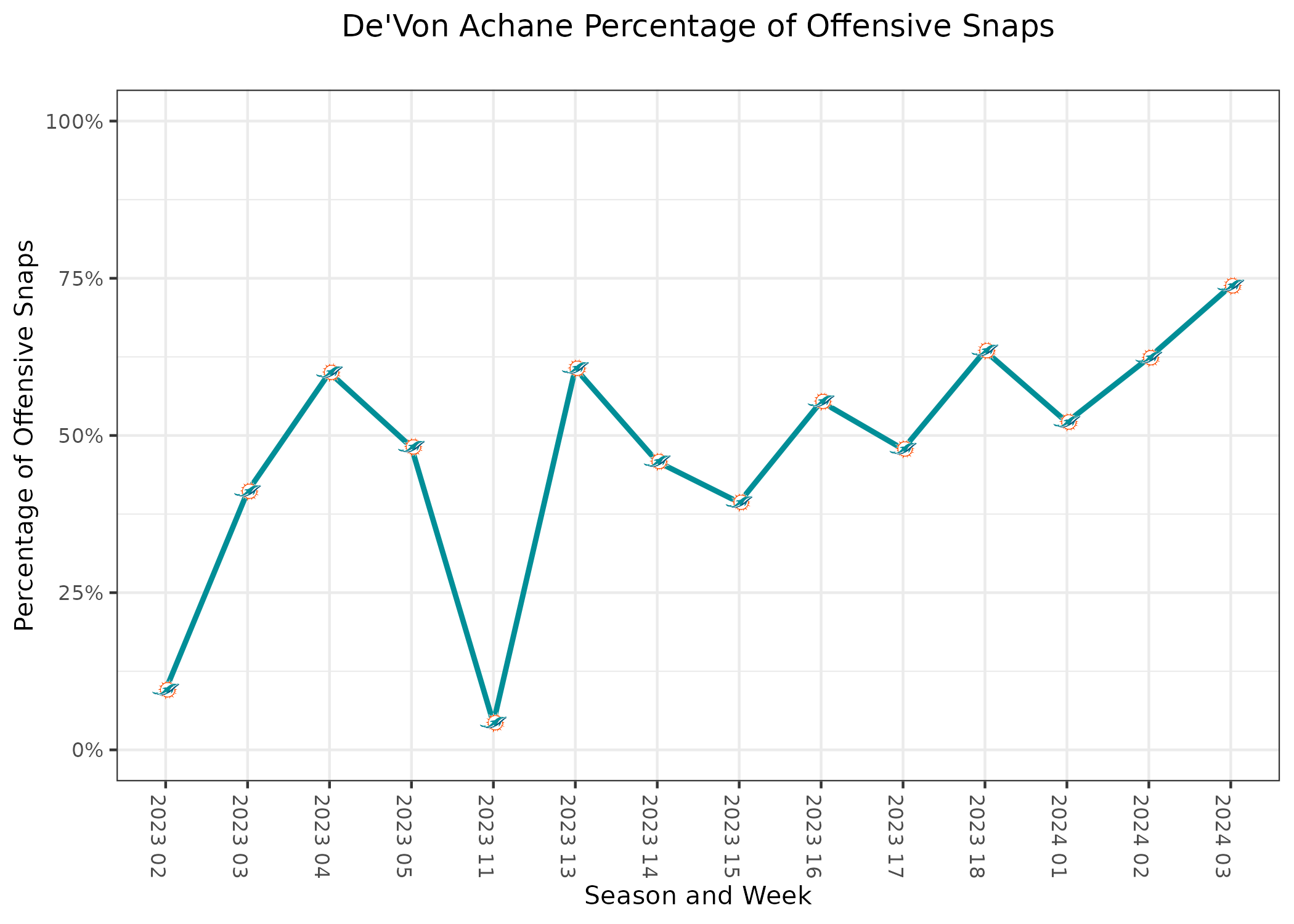
Miscellaneous Notes
- Kenneth Walker III missed his second straight game due to an oblique injury. Zach Charbonnet completely dominated offensive snaps, similar to last week.
- With Tua Tagovailoa on injured reserve, Skylar Thompson started. He suffered a chest injury in the middle of the third quarter and didn’t return. Tim Boyle took over for the rest of the game.
- The Dolphins made some changes to their backup wide receivers. Robbie Chosen was released. Grant DuBose landed on injured reserve due to a shoulder injury, and Malik Washington was inactive with a quadriceps injury. This left the team elevating both Erik Ezukanma and D'Wayne Eskridge from the practice squad.
- This game should have been the perfect time for Jonnu Smith to shine, a game script that forced Miami to pass, and the quarterback injuries made the team focus on players with a lower average depth of target. Instead, Smith ran a route on 43% of the team's pass plays and caught two-of-three targets for 18 yards.
Detroit Lions @ Arizona Cardinals
- David Montgomery: 23 carries, 106 yards, 1 touchdown, 3 receptions, 17 receiving yards
- Amon-Ra St. Brown: 7 receptions, 74 yards, 1 touchdown

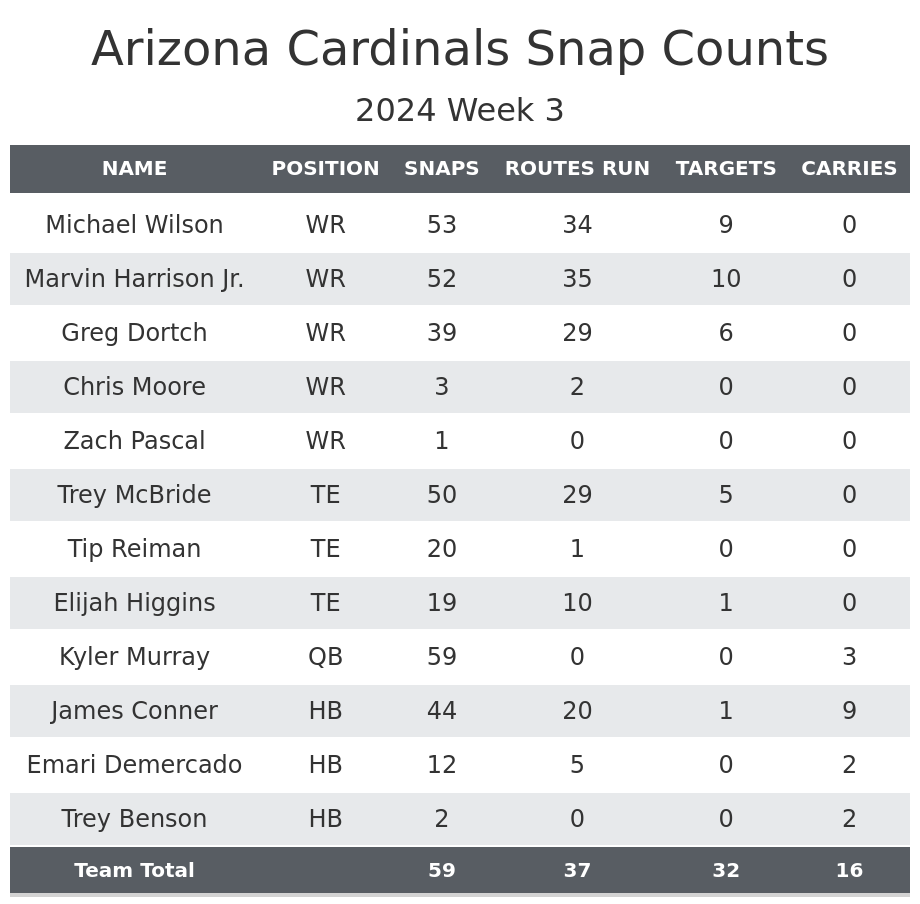
Monitor Sam LaPorta’s health: LaPorta reportedly suffered a sprained ankle in this game.
The Lions started this game with a lot of snaps out of 12 personnel. LaPorta played 32-of-34 snaps in the first half, while Brock Wright played 20. LaPorta played in the second half but rotated much more than usual. He played 11-of-34 snaps, while Wright played 27-of-34.
Considering he was able to keep playing throughout the game, ideally, he will be able to play next week. If he’s out, Brock Wright would be the Lions' every down tight end. Considering Wright’s history in the offense and high target share when on the field, he would be worth considering if LaPorta misses time. Parker Hesse is the Lions' third tight end and was active this week, but he didn’t play a snap on offense.
Monitor Trey McBride’s health: McBride took a helmet-to-helmet hit in the fourth quarter and is in the concussion protocol.
McBride had his usual role most of the game, playing 37-of-40 snaps in the first three quarters. The Cardinals only ran five more plays after the hit, and Elijah Higgins played all five snaps over run-blocking rookie tight end Tip Reiman.
If McBride ends up missing a game, Higgins would be the waiver-wire target on the team. Chances are the team will focus more on the wide receivers, so if you need a tight end, it’s probably best to look elsewhere.
Miscellaneous Notes
- Sophomore wide receiver Michael Wilson had the second-best game of his season with eight receptions for 64 yards. He is a waiver target in deeper leagues, and there is a chance he will continue to be a factor in future weeks.
- Tim Patrick was elevated from the practice squad for a second straight week. Rather than rotating with Kalif Raymond, he was the clear third wide receiver.
- Allen Robinson II was also elevated off the practice squad for this week, but he only played one snap on offense.
Baltimore Ravens @ Dallas Cowboys
- Derrick Henry: 25 carries, 151 yards, 2 touchdowns, 1 reception, 23 receiving yards
- Jake Ferguson: 6 receptions, 95 yards
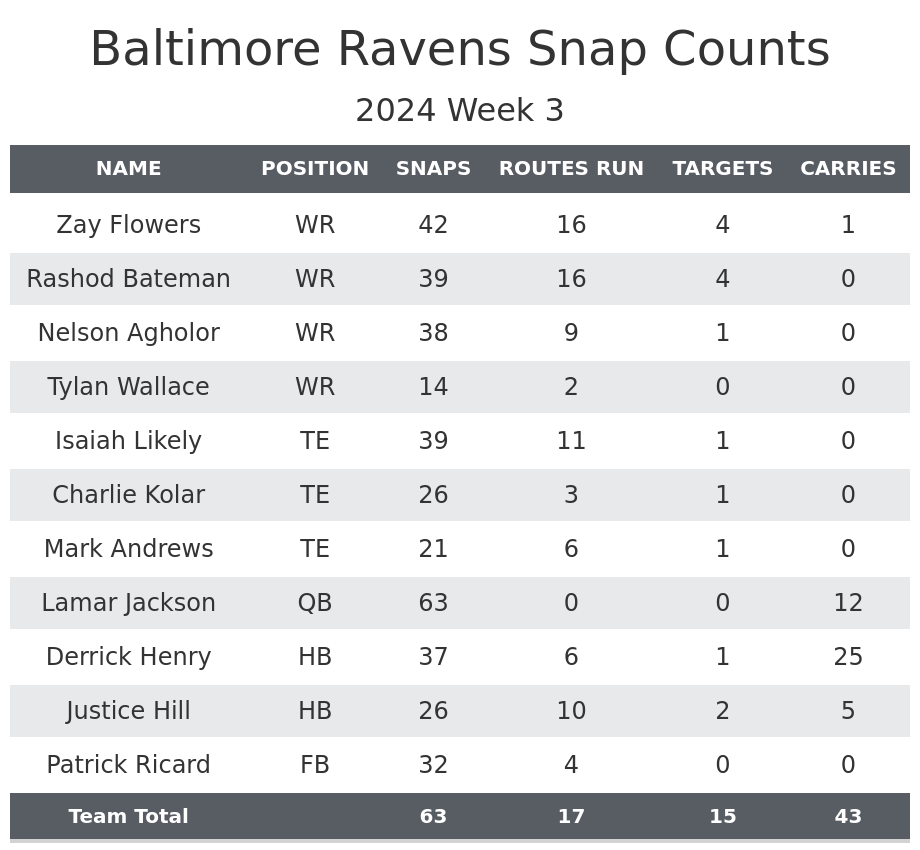

Cowboys further complicate backfield: Five players played at least one snap at halfback for the Cowboys.
In the first two weeks, the Cowboys generally rotated Rico Dowdle and Ezekiel Elliott by drive while Deuce Vaughn mixed in a little more. This week, fullback/halfback hybrid Hunter Luepke took over as the primary passing-down back, playing 80% of the Cowboys' third down snaps and a third of the two-minute drill snaps. The Cowboys also ran five plays with CeeDee Lamb lined up in the backfield.
Outside of the third downs, Dowdle played snaps on each of the first two drives, while Ezekiel Elliott did not play until the third drive. In the fourth quarter while the Cowboys were trying to catch up, Elliott only played two of a possible 31 snaps, while Dowdle played 17 and Luepke played eight.
At this point, it’s safe to drop Elliott, who has played fewer snaps each week. At this point, his role isn’t as big as it was with the New England Patriots. Even if Dowdle is injured, Elliott wouldn’t have a feature role. If the team decides to elevate Dalvin Cook from the practice squad, Elliott could very well be the odd man out. Elliott's paths to fantasy value this season have quickly disappeared.
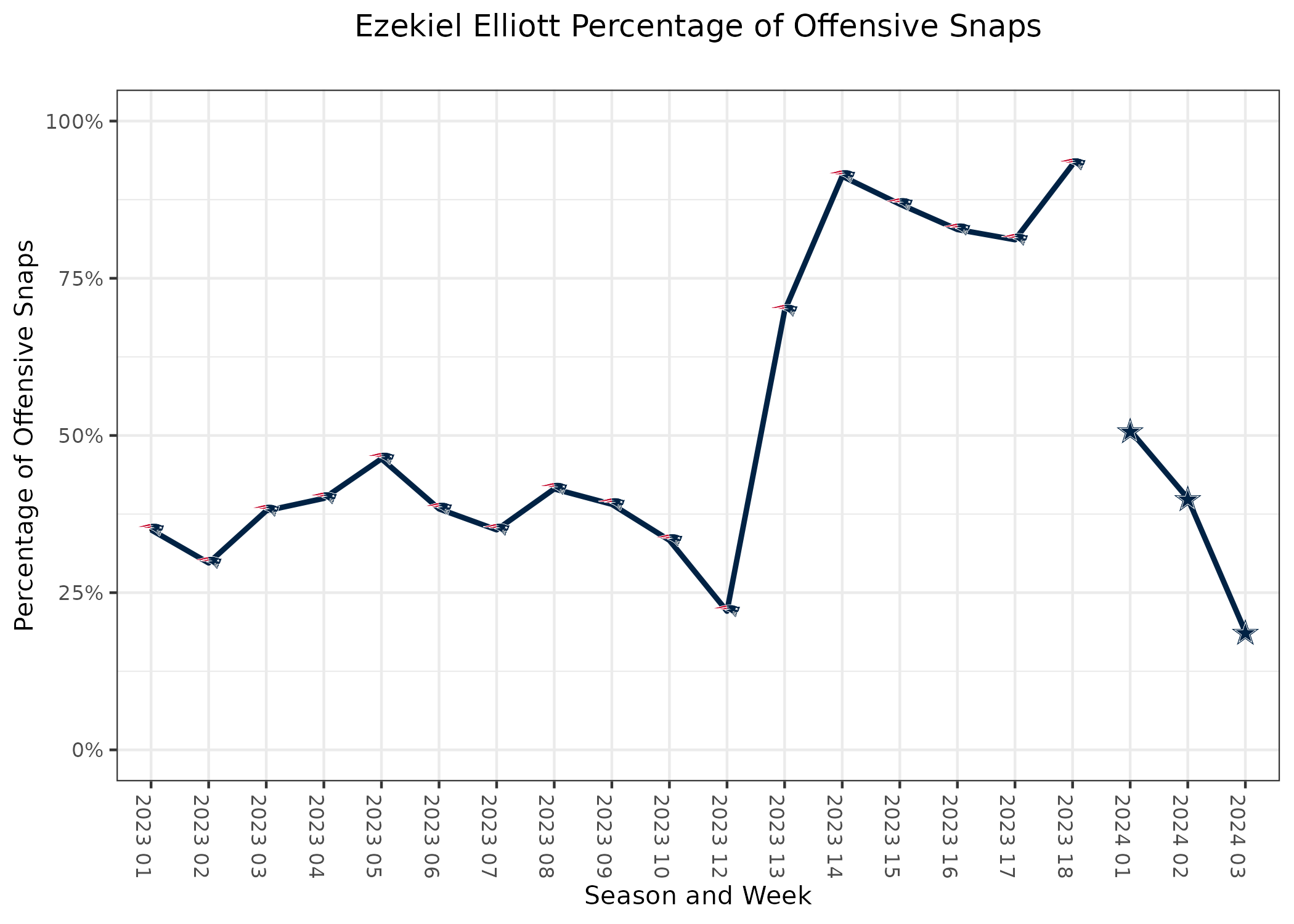
Mark Andrews and Isaiah Likely combined for four yards: The Ravens built a 21-3 lead by halftime, which was a nightmare for their receivers in fantasy.
Likely’s biggest problem was the game script and a low target share. Lamar Jackson only attempted 15 passes, targeting Likely once for a four-yard completion. His playing time was generally promising. He’s played 100% of Baltimore's snaps in 22 and 12 personnel, which continued in this game. He played 10-of-19 snaps in 11 personnel, which is a big step up from last week. He also played four snaps in 21 personnel after just one snap there over the first two games.
This game was a nightmare for Andrews’ fantasy managers. He doesn’t play in 22 personnel, as Charlie Kolar is the other tight end in that group. The Ravens used 22 on 14 snaps. He had played the clear majority of the team's snaps in 11 personnel last week but lost some of those snaps to Likely. The other big problem is he played seven-of-21 snaps in 21 personnel in the first two weeks, and he didn’t play at all in that personnel grouping (16 snaps) in this game. Andrews didn’t catch his only target.
If this usage carries on to future weeks, Likely will consistently run more routes than Andrews going forward. The Ravens have used their tight ends in 11 personnel differently each week, so there is a chance this changes again. It’s too early to give up on Andrews completely, but we’ve probably reached a point where he can’t be in fantasy starting lineups going forward.
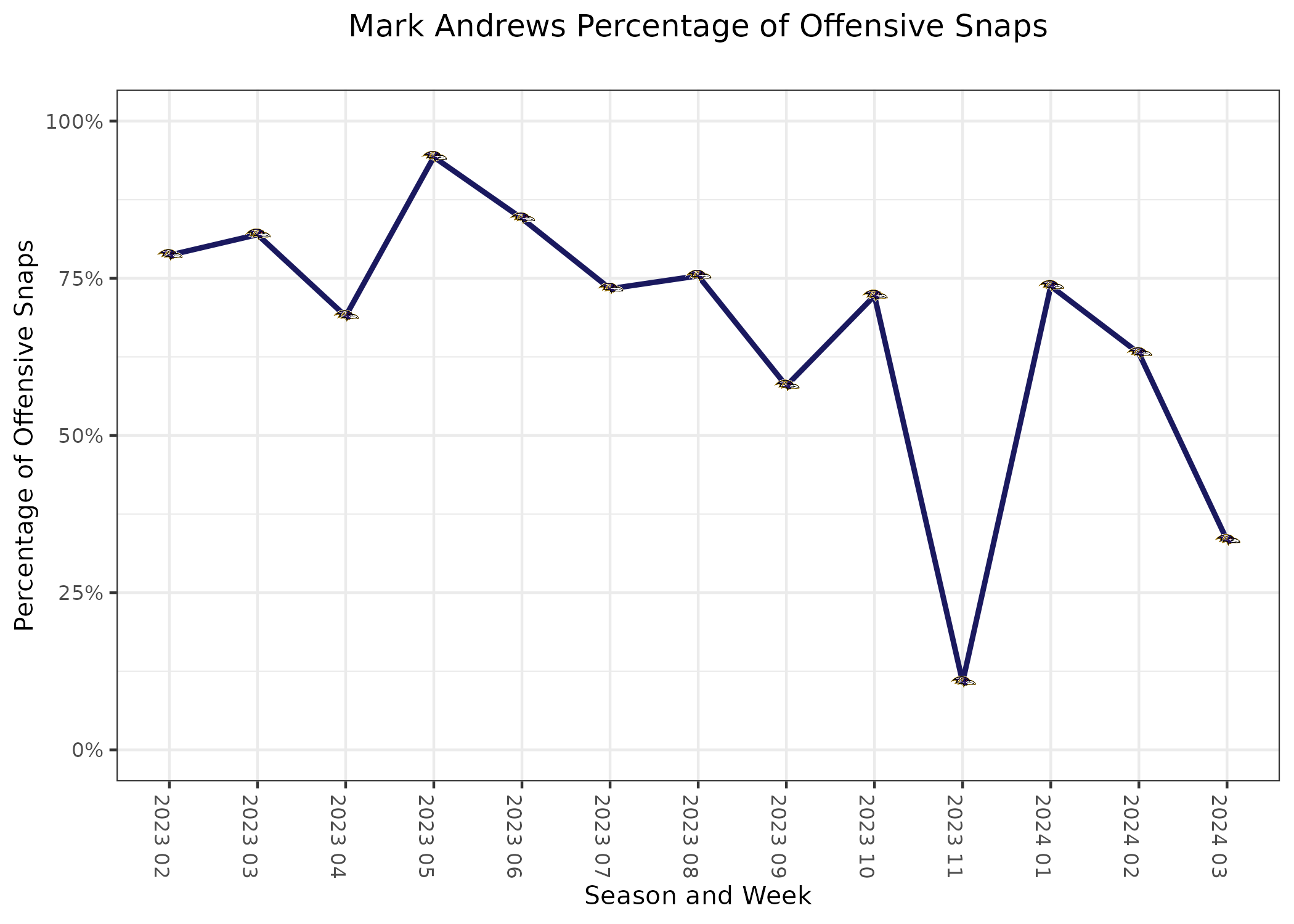
Miscellaneous Notes
- Jake Ferguson returned to the Cowboys after missing last week. He rotated out a little more than expected compared to the end of last season, particularly in run situations, but he’s still safe to return to fantasy starting lineups.
- This game is the perfect example of why Justice Hill doesn’t need to be on fantasy rosters. The Ravens ran 45 times compared to 15 pass attempts. Hill averaged over 10 yards per reception and over six yards per carry but still only managed 7.4 PPR points.
San Francisco 49ers @ Los Angeles Rams
- Jauan Jennings: 11 receptions, 175 yards, 3 touchdowns
- Kyren Williams: 24 carries, 89 yards, 2 touchdowns, 2 receptions, 27 receiving yards, 1 receiving touchdown

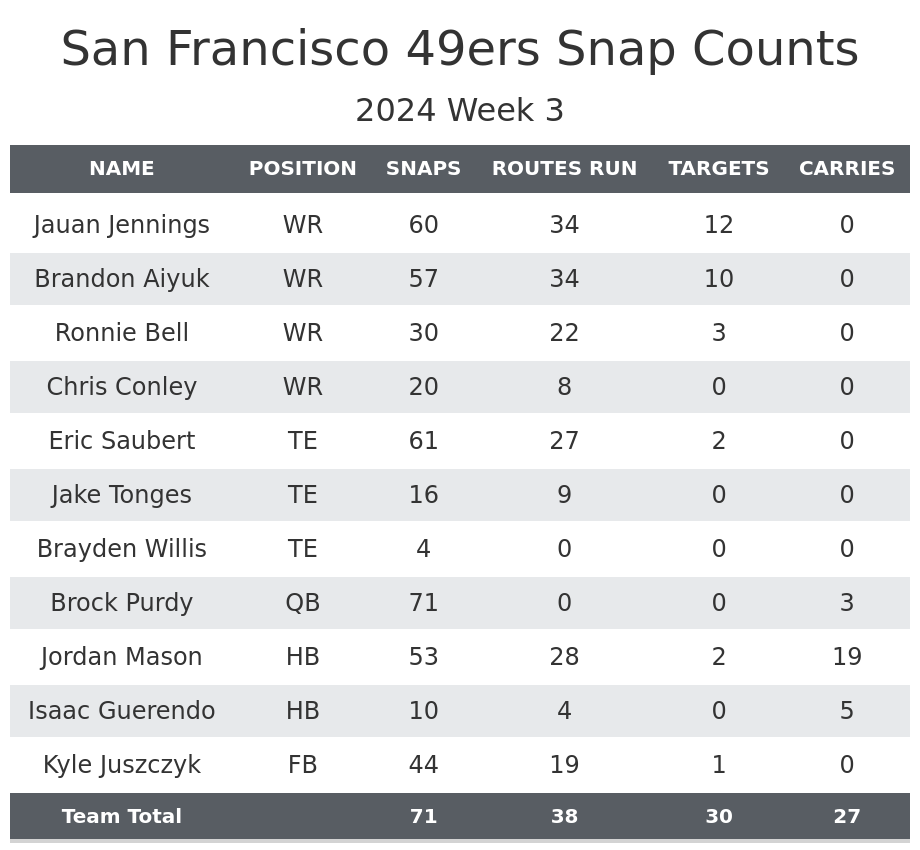
Jauan Jennings dominates without Deebo Samuel: Samuel missed this week due to a calf injury.
Jennings typically only plays in three-receiver sets. He wasn’t an obvious waiver-wire target because in 21 personnel this season, Chris Conley had played 18 snaps compared to Jennings' 10 and Ronnie Bell‘s five. Conley and Jennings had both played four snaps in 12 personnel. This made it seem like Jennings would see an increase in snaps, but it might not be that significant.
Instead, Jennings played 28 of a possible 31 snaps in 21 personnel and three-of-five in 12 personnel Sunday. He was a clear, every-down receiver. His target share was even more significant, as he received more targets than Brandon Aiyuk. Jennings posted what could have been the best receiving numbers by a player in a game this season with nearly 50 PPR points.
While we shouldn’t expect this many touchdowns going forward, Samuel is expected to miss a few weeks, leaving Jennings as a starter for the near future. Once George Kittle returns, that will also lessen Jennings’ target share. In some fantasy leagues, someone is bound to overpay for Jennings given his stat line, but it’s still worth trying to get him in the short run, even if he loses his fantasy value in a few weeks.
When the 49ers lined up in 11 personnel, Ronnie Bell typically took Samuel’s spot out wide. In very deep leagues, Bell would be the player to target over Conley.
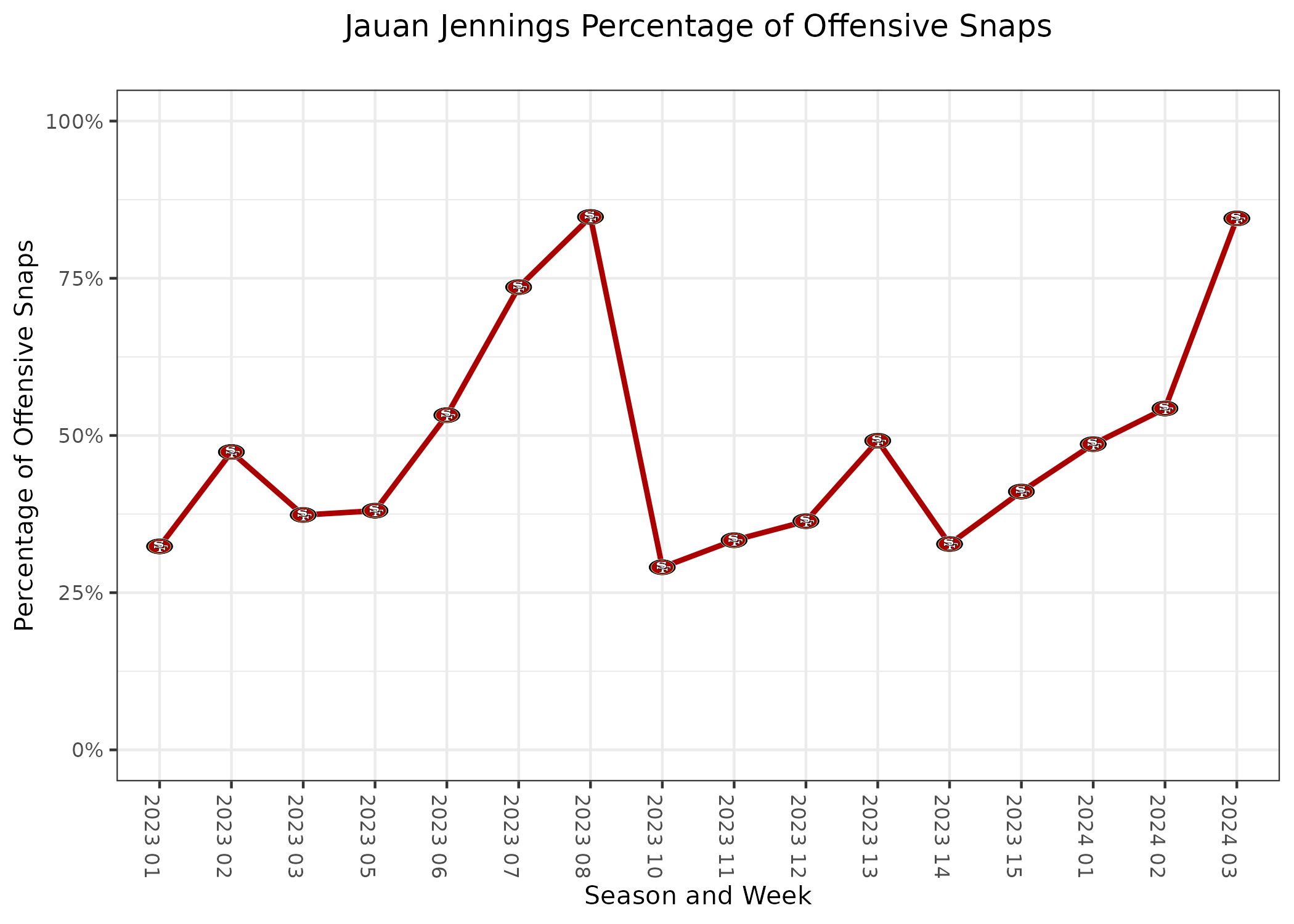
Tutu Atwell shines among Rams wide receivers: Puka Nacua is on injured reserve while Cooper Kupp is out due to an ankle injury, leading to an unlikely wide receiver stepping up.
Demarcus Robinson has been a starter all season. Tyler Johnson took over once Nacua went down, and Jordan Whittington took over once Kupp suffered his injury. It seemed like those three would be the primary wide receivers in this game. There was fair debates on which of the three would have more fantasy value.
Instead, the former second-round pick started the game with Robinson and played the majority of snaps. Atwell was typically a starter last season before losing his job to Robinson. Atwell led the team in receptions and led the team in receiving yards from his 50-yard reception alone. He caught four passes for 93 yards, while the next closest was Robinson with 32.
It will be hard to trust any of these Rams wide receivers going forward because we could see someone else emerge next week. A reasonable argument could be made for any of them, but it’s worth picking up Atwell in case he has a similar performance next week.
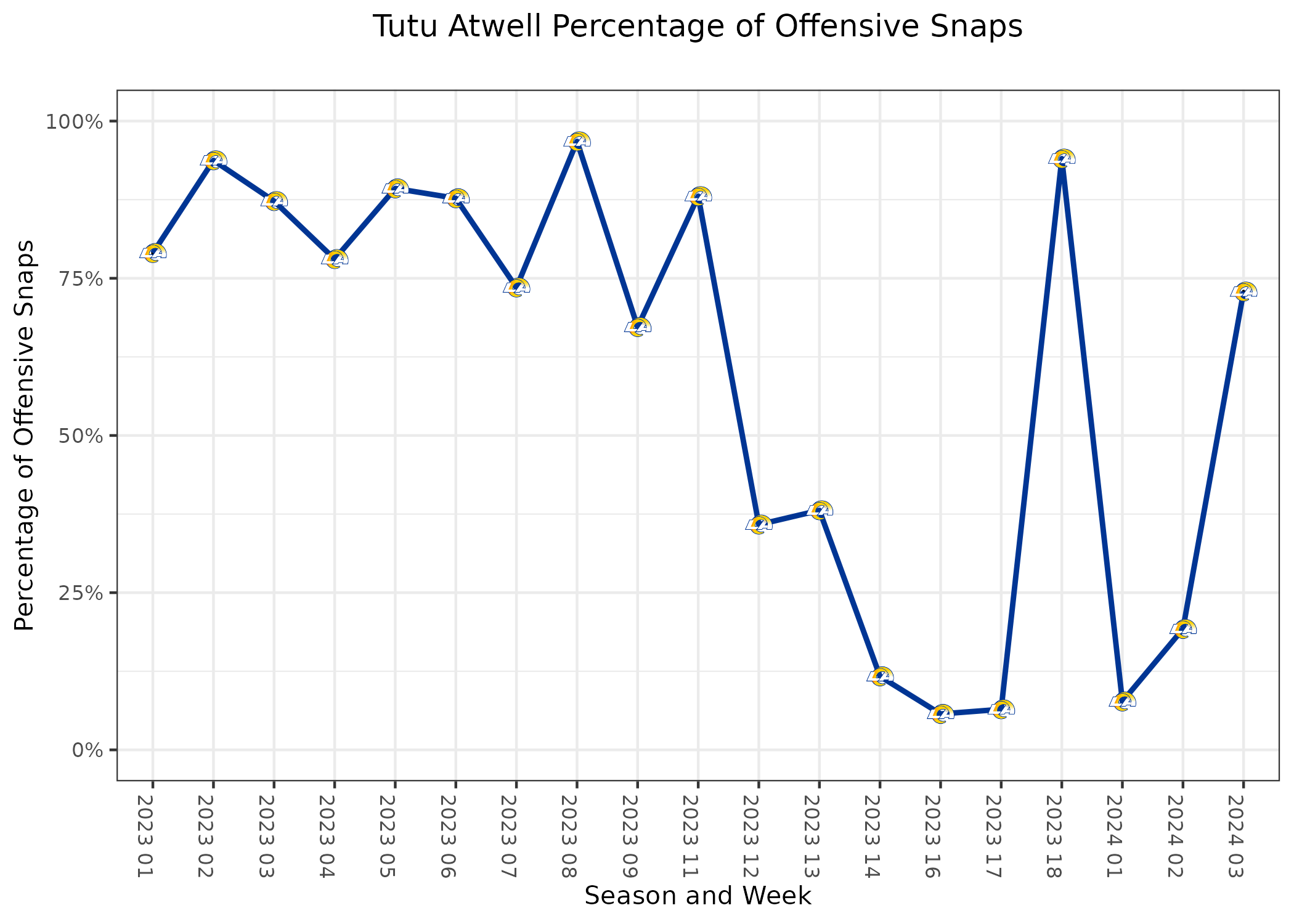
Miscellaneous Notes
- The 49ers rotated Jordan Mason out slightly more this week, as Kyle Juszczyk played more consistently on third downs while Isaac Guerendo played more without Deebo Samuel taking running back snaps.
- Eric Saubert was generally George Kittle‘s replacement, but in 11 personnel, Saubert only played 17-of-25 snaps while Jake Tonges played the other eight. Had the 49ers been playing from behind all game, we likely would have seen more Tonges and less Saubert compared to what actually happened.
- Rams backup tight end Davis Allen missed his second straight game due to a back injury.
Kansas City Chiefs @ Atlanta Falcons
- Rashee Rice: 12 carries, 110 yards, 1 touchdown
- Drake London: 6 receptions, 67 yards, 1 touchdown
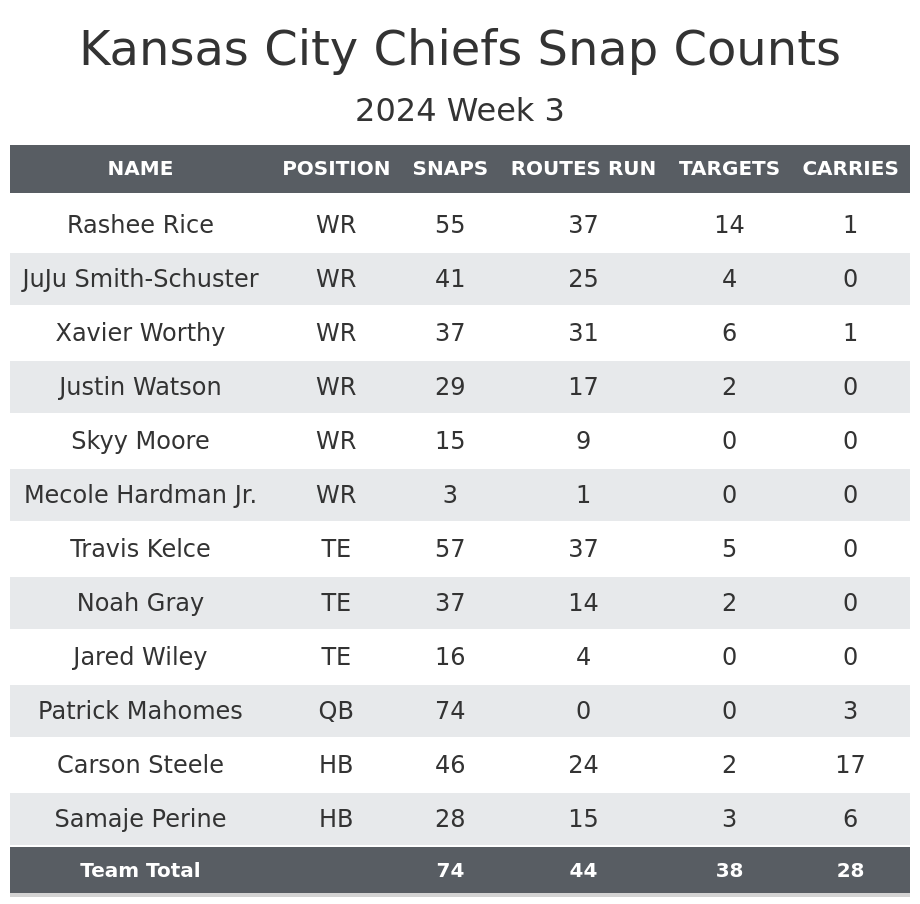
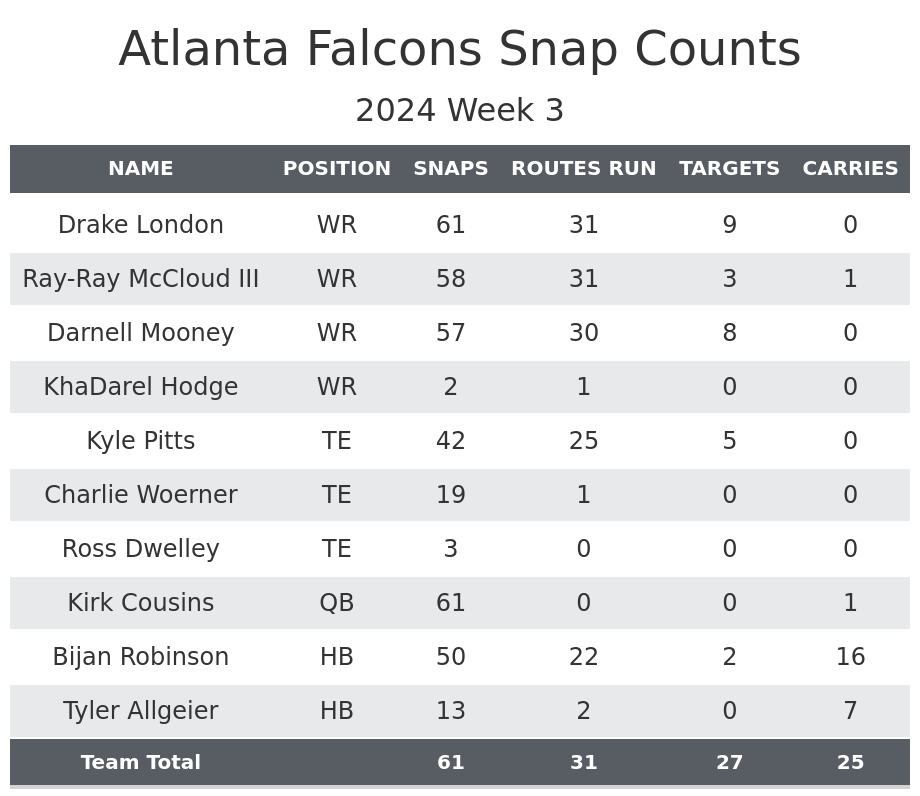
Carson Steele leads Chiefs backfield: Steele led Kansas City's two-man rotation with 17 carries for 72 yards.
The Chiefs recently signed Keaontay Ingram to the active roster and Kareem Hunt to the practice squad. But this week, the Chiefs used only two running backs.
Steele played the majority of snaps on early downs, at the goal line and in short-yardage situations. As expected, Samaje Perine remained the receiving-down back and was the backup in rushing situations.
Perine's limited role doesn't offer much fantasy value. He carried the ball six times for 25 yards and caught three passes for 15 yards. Unlike Jerick McKinnon, who previously held this role and was frequently used at the goal line — resulting in several touchdowns — Perine is less likely to see goal-line opportunities. Therefore, he probably doesn't need to be rostered in most fantasy leagues.
There is certainly a chance Hunt joins the active roster or Clyde Edwards-Helaire returns. However, if the Chiefs stick to their usual approach, it’s likely they would reduce Perine's snaps on early downs and short-yardage situations before affecting Steele’s workload. Given Steele’s effectiveness in the run game, his role seems secure, at least for the near future.
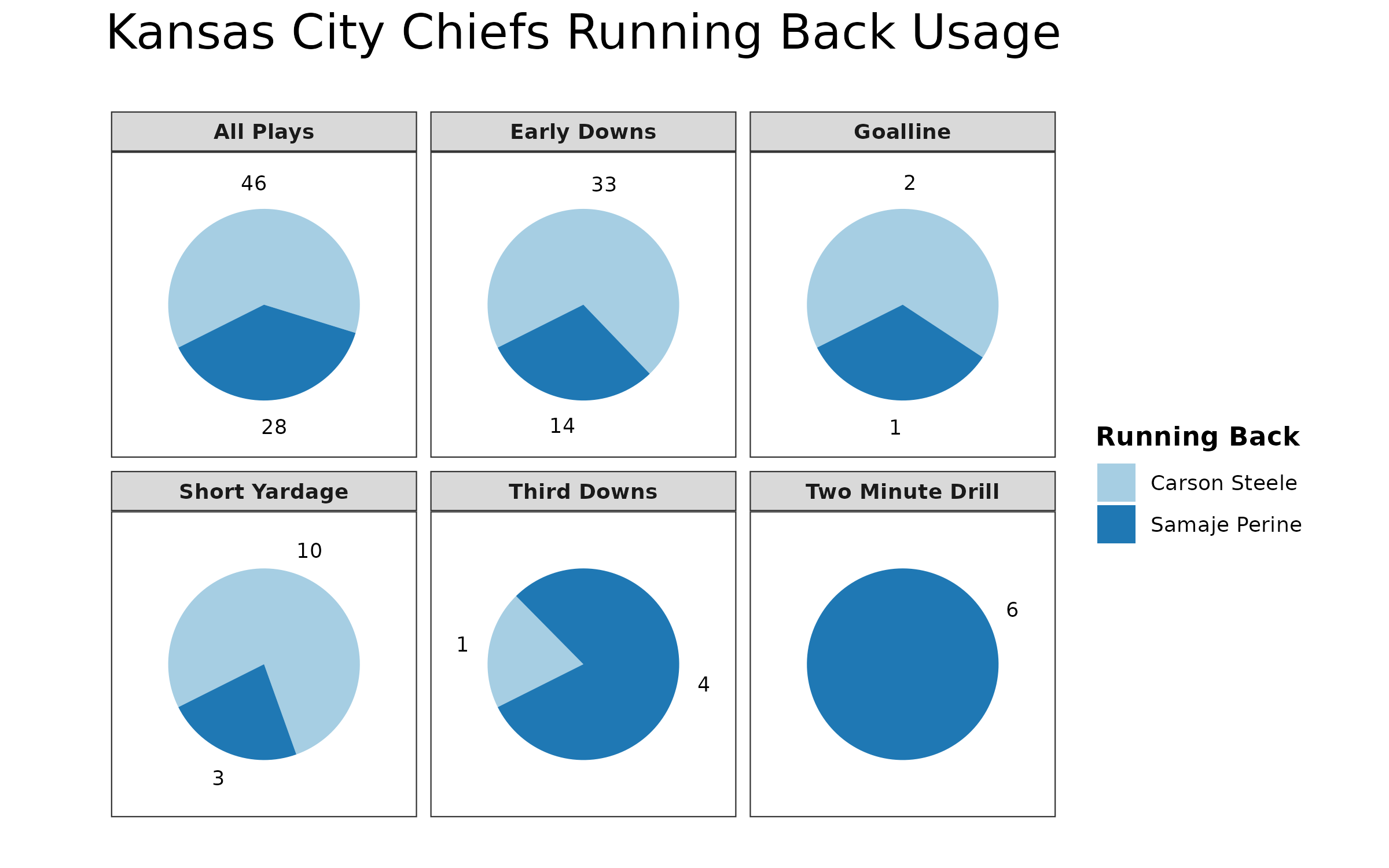
JuJu Smith-Schuster takes a larger role: Smith-Schuster cut into the playing time of both Xavier Worthy and Justin Watson.
The veteran served as a backup for the first two weeks of the season but emerged as a much bigger part of the wide receiver rotation in Week 3. Smith-Schuster was the primary wide receiver in 13 personnel and rotated with Watson in 12 personnel. Worthy had played 26 of 36 snaps in 12 personnel in his team's first two games but barely played there this week. In 11 personnel, Smith-Schuster surpassed Watson on the depth chart.
Rashee Rice, Smith-Schuster and Worthy all played significantly in the slot.
Rice is averaging over 3.0 yards per route run and has a target rate of over 30% playing in the slot and out wide for Kansas City this season. So, the change is unlikely to impact Rice’s fantasy value, and it certainly didn’t this week. If this change sticks, it will be harder to put Worthy in fantasy starting lineups.
Kyle Pitts in a rotation: Pitts' playing time has decreased since Week 1, resembling the trend we saw at the end of last season.
Last season, Pitts was rotated out frequently early on, but his playing time gradually increased as the season progressed. A source of frustration for fantasy managers was the fact that Jonnu Smith had fantasy value at times, and other tight ends were regularly involved, limiting Pitts' consistent presence on the field.
In the Falcons' new offense, they primarily operate in 11 personnel, which keeps just one tight end on the field. In Week 1, Pitts was rarely rotated out. However, in recent weeks, Charlie Woerner has taken a larger share of early-down snaps. As a result, Pitts ran a route on 74% of the Falcons' passing plays last week while participating in 72% of offensive snaps. This week, despite being rotated out even more, he ran a route on a higher percentage of passing plays.
This is still an improvement from last season and better than most tight ends in the league, though it falls short of the ideal rate Pitts reached in Week 1. He was targeted five times, catching two passes for 59 yards. Those two plays alone were enough to rank ninth in PPR points among tight ends this week. While Pitts remains a viable fantasy starter, he has yet to fully meet expectations this season.
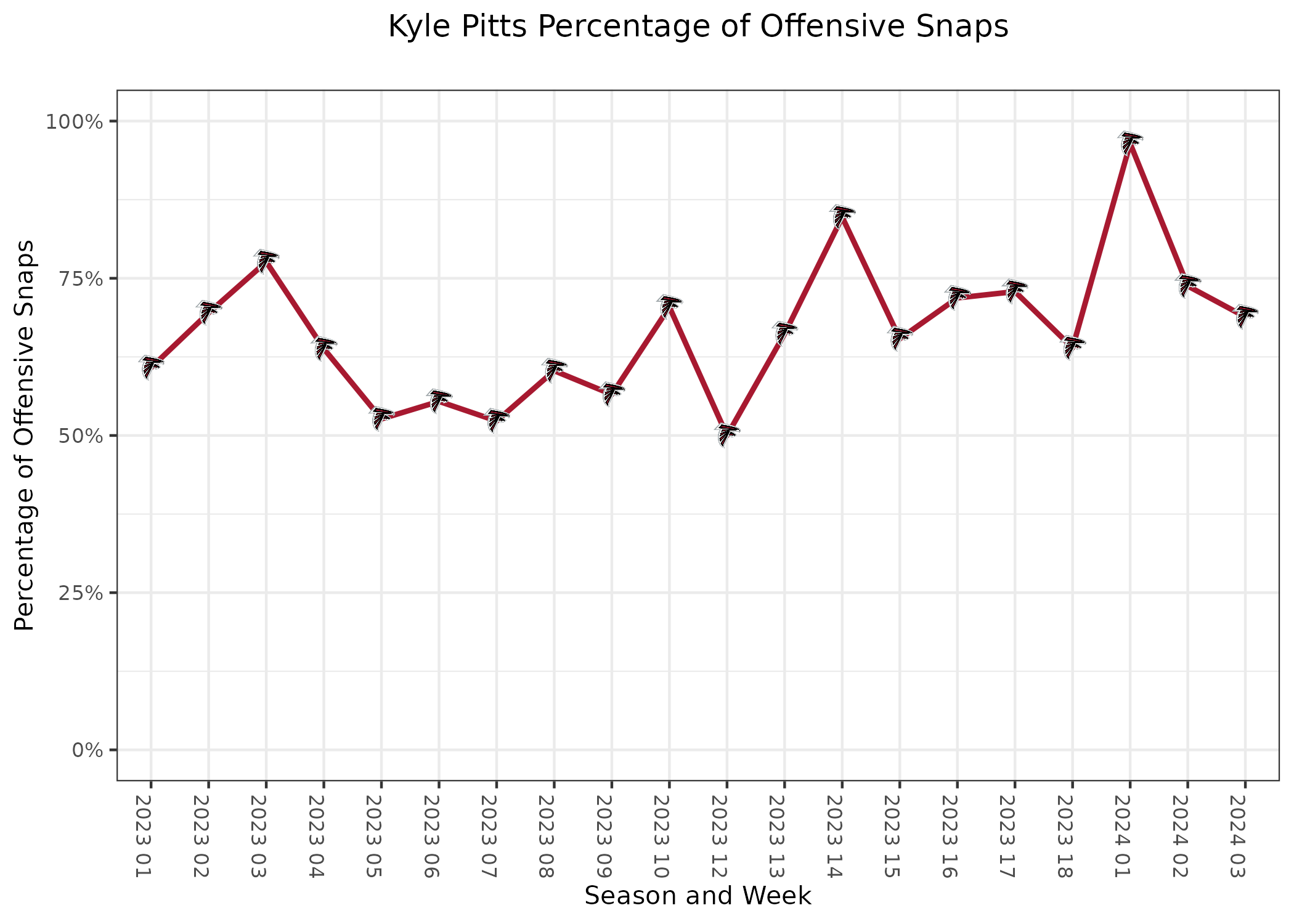
Miscellaneous Notes
- After three weeks, Darnell Mooney and Ray-Ray McCloud III lead the team in receiving yards. All five starting skill players have a target rate between 13% and 20% this year.
- Travis Kelce has been held under 35 yards without a touchdown in all three games this season. He did this only three times during the entire 2023 season.
Table Notes
- Snaps include plays called back due to penalties, including offensive holding or defensive pass interference. The other three stats have these plays removed.
- Targets may differ from official NFL sources. The most likely discrepancy would be from a clear thrown-away pass, where the NFL may give the target to the nearest receiver, while this data will not.
- Carries are only on designed plays. Quarterback scrambles won’t count for the total number of carries in the game.




 © 2024 PFF - all rights reserved.
© 2024 PFF - all rights reserved.